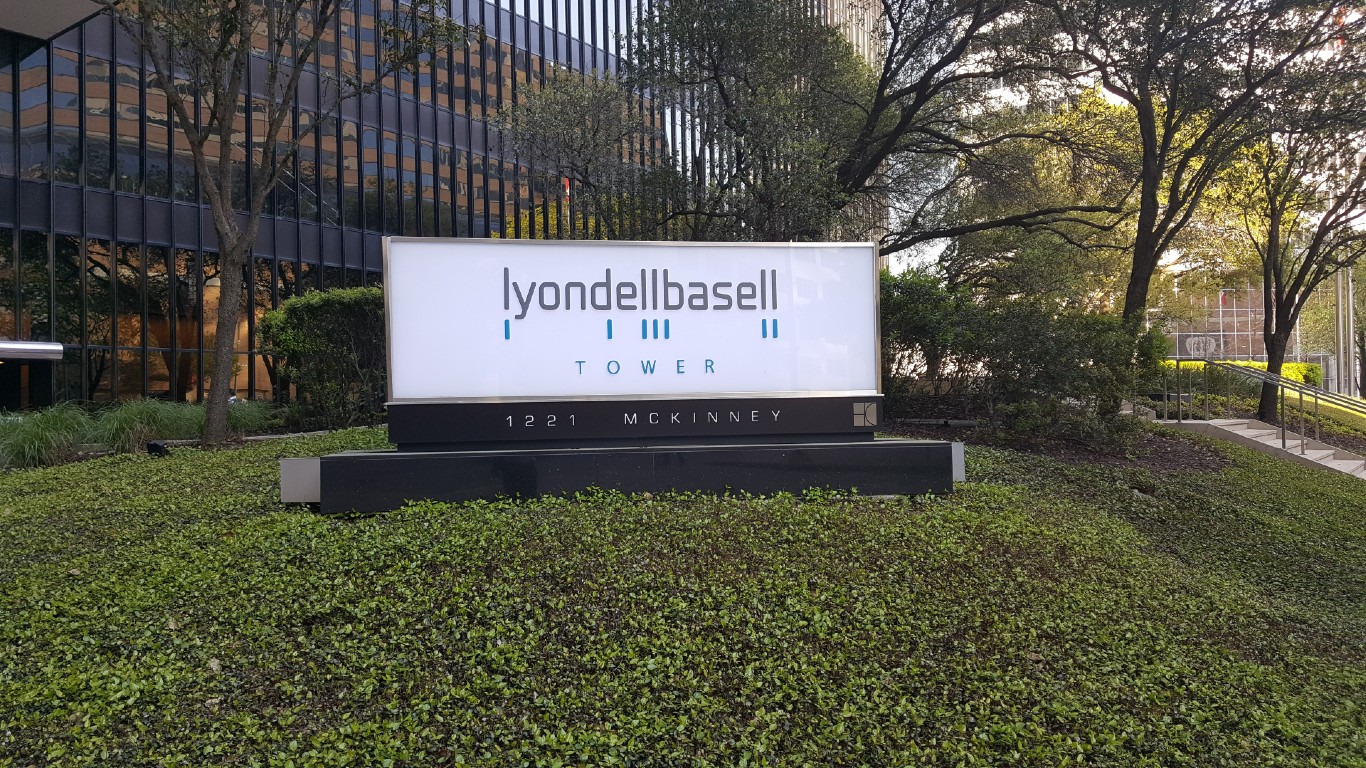
Millions of pounds of toxic materials are released into the nation’s waters every year, legally. Industries that need to dispose of toxic wastewater may do so by obtaining a NPDES – National Pollutant Discharge – permit, or a state discharge permit when the state is authorized by the federal government to issue them.
Companies release the wastes usually through closely monitored outfalls into local lakes or streams, or conveyed to the local sewage treatment plant. Because municipal treatment plants are not generally equipped to treat toxic waste, the waste is released into surface waters along with treated sewage wastewater.
The condition and amounts of waste allowed to be discharged depend on the quality and capacity of the receiving waters, so that the body of water is not impaired for its classified use, such as fishing, swimming, drinking, or the health of aquatic life. As the cynical description of this system goes, dilution is the solution to pollution. (These are America’s most endangered rivers.)
To identify the 50 companies polluting our water, 24/7 Wall St. reviewed Political Economy Research Institute’s report, Toxic 100 Water Polluters Index (2021 Report, Based on 2019 Data).
The report includes the top 100 companies that emit the greatest amount of toxic water hazards. To measure toxic hazard, the report uses the Environmental Protection Agency’s Risk-Screening Environmental Indicators.
Specifically, companies are ranked by their RSEI hazard, or toxic hazard, which is measured by adding pounds released directly to surface water and pounds transferred to public owned treatment works multiplied by chemical-specific toxicity weights. POTW are public water treatment plants. The report’s environmental justice measures include the percentage of the population living under twice the poverty line and the share of the population from minority racial/ethnic groups that are at risk for exposure to dangerous water from these emitters.
It has been well established that poor and minority populations suffer disproportionately from noxious land uses in their communities, and the toxic wastewater data bear this out. (These are states where schools have the most toxic air.)
Twenty-eight of the companies adding toxics to our waters are located upstream of communities in which at least 30% of the residents live below twice the poverty line – nationwide, 26% of the population live below twice the poverty line. However, unlike pollutants emitted into the air, the health impacts of water pollution can be controlled to a large degree, by treating drinking water, for example, or banning certain bodies of water for some uses, such as swimming or fishing for consumption.
Of greater concern are pollutants that escape into the environment without permits or monitoring, and often without detection. Some of the coal-fired power plants noted below have historically stored their highly contaminated coal ash in unlined pits that ultimately leach into groundwater. These are not accounted for in determining the level of pollution released from a plant.

50. Michelin
> Toxic hazard (pounds released x toxicity): 233,100,580
> Environmental justice, poor population share 36% – #32 highest out of 100 corporations
> Environmental justice, minority population share 43% – #27 highest
> Pct. of toxic hazard from a single facility: 100% – #1 highest
Michelin and its subsidiaries operate plants in North and South Carolina, Alabama, and Indiana, all of which discharge some relatively small amounts of toxic chemicals. A single facility in Louisville, Kentucky, however, discharges tens of thousands times more toxic pollution than the other 12 plants combined. The facility, run by the American Synthetic Rubber Company, was fined $135,000 in 2019 for leaking 4,000 pounds of 1,3-butadiene, a carcinogenic compound used in making synthetic rubber.
[in-text-ad]

49. Domtar Corp.
> Toxic hazard (pounds released x toxicity): 240,673,385
> Environmental justice, poor population share 15% – #94 highest out of 100 corporations
> Environmental justice, minority population share 16% – #73 highest
> Pct. of toxic hazard from a single facility: 39% – #90 highest
Domtar is a major paper, pulp, and packaging company with mills in eight states. The company touts its environmental record, reporting that it has reduced the amount of waste going to landfills by 34% since 2013 and reduced its greenhouse gas emissions by 27% since 2010. Its environmental reputation has needed bolstering since at least 2011, when it paid nearly $2 million in fines and cleanup costs for environmental violations.
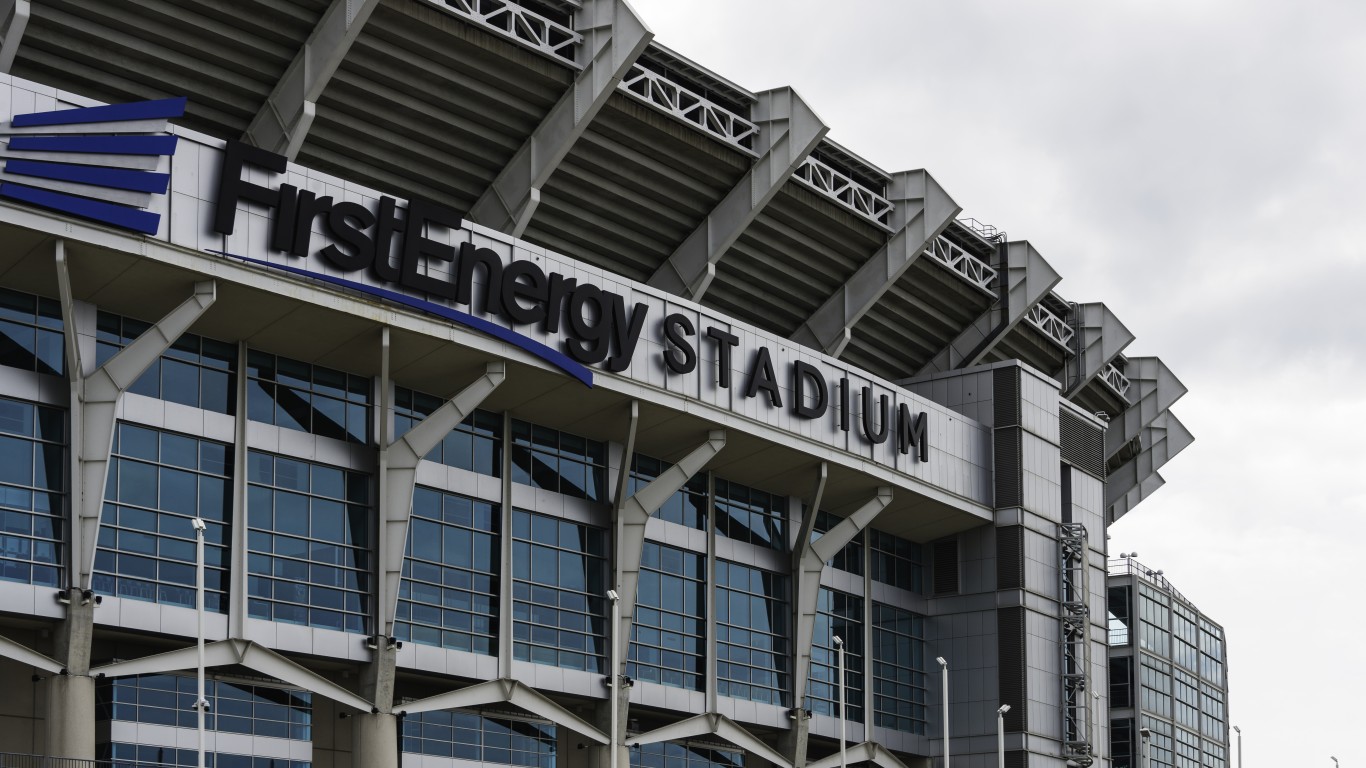
48. FirstEnergy
> Toxic hazard (pounds released x toxicity): 242,514,114
> Environmental justice, poor population share 35% – #39 highest out of 100 corporations
> Environmental justice, minority population share 14% – #76 highest
> Pct. of toxic hazard from a single facility: 68% – #67 highest
Operating 10 electric utility companies in five states that require water permits, FirstEnergy has two facilities in West Virginia that are poorly managing waste and wastewater from their coal-fired power plant operations. Both are regularly in non-compliance with the terms of their permits, and one, Harrison Power Station, has been cited with continuous “significant violations.”

47. DuPont de Nemours
> Toxic hazard (pounds released x toxicity): 269,430,449
> Environmental justice, poor population share 38% – #25 highest out of 100 corporations
> Environmental justice, minority population share 43% – #27 highest
> Pct. of toxic hazard from a single facility: 75% – #61 highest
Of the 18 divisions and subsidiaries of chemical company DuPont de Nemours that hold environmental permits, Filmtec in Minnesota is responsible for more than 75% of its toxic wastewater output. Ironically, the company is noted for its production of semipermeable membranes, mainly used in water treatment and desalination systems.
[in-text-ad-2]

46. PTT Group
> Toxic hazard (pounds released x toxicity): 276,555,240
> Environmental justice, poor population share 29% – #58 highest out of 100 corporations
> Environmental justice, minority population share 14% – #76 highest
> Pct. of toxic hazard from a single facility: 100% – #1 highest
PTT Group, a Thai petrochemical corporation, has a 50% interest in Emery Oleochemicals, which produces specialty chemicals from natural oils and fats and is operating out of Cincinnati. The company, which began as a candle manufacturer in 1840, recently won an award from the Ohio Chemistry Technology Council for its program to reduce its water discharges. In 2020, the company reduced its wastewater volume by 14% and its organic waste concentration by 25%, compared to its 2018/2019 average.

45. Compass Group
> Toxic hazard (pounds released x toxicity): 280,605,131
> Environmental justice, poor population share 21% – #80 highest out of 100 corporations
> Environmental justice, minority population share 4% – #94 highest
> Pct. of toxic hazard from a single facility: 100% – #1 highest
The Compass Group is the parent company of six different businesses, mainly related to security and electronics, requiring environmental permits, and mainly releasing small quantities of pollutants into surface waters or treatment plants. The exception is Crosman Corp., a manufacturer of high quality air rifles, air pistols, and ammunition, which is responsible for nearly 100% of the Compass Groups toxic releases.
[in-text-ad]
44. WH Group
> Toxic hazard (pounds released x toxicity): 292,997,251
> Environmental justice, poor population share 20% – #84 highest out of 100 corporations
> Environmental justice, minority population share 36% – #36 highest
> Pct. of toxic hazard from a single facility: 64% – #73 highest
Much better known by a name used by most of its subsidiaries, Smithfield, the WH companies raise livestock and process meat products. Two of the companies, one in Iowa and the main plant in Virginia, release about 98% of the company’s toxic wastewater, made up of chemicals used in meat processing and for plant sanitation and maintenance.operations.

43. Phillips 66
> Toxic hazard (pounds released x toxicity): 312,540,218
> Environmental justice, poor population share 31% – #50 highest out of 100 corporations
> Environmental justice, minority population share 64% – #11 highest
> Pct. of toxic hazard from a single facility: 75% – #61 highest
Phillips 66 and its petrochemical affiliates have over two dozen manufacturing plants, terminals, and refineries throughout the country, predominantly in the West and Southwest. Among these, a single refinery in Carson, California, releases 75% of the company’s total toxic output. All of its 387,227 pounds of liquid chemical waste goes into a POTW, more commonly known as a municipal sewage treatment plant.

42. Lonza
> Toxic hazard (pounds released x toxicity): 329,989,846
> Environmental justice, poor population share 31% – #50 highest out of 100 corporations
> Environmental justice, minority population share 85% – #1 highest
> Pct. of toxic hazard from a single facility: 100% – #1 highest
Lonza is an old and established Swiss pharmaceutical and chemical manufacturer with locations all over the world. The company purchased Arch Wood Protection, Inc. in 2011, expanding its product lines to include wood preservatives. Arch Wood uses a variety of chemicals in the manufacture of pressure-treated wood, including arsenic, and the waste from its processes goes directly into surface waters in Georgia. While this amounted to only 323 pounds in 2019, because of the high toxicity of the chemicals involved, the discharge represents nearly 100% of the company’s total American toxic hazard.
[in-text-ad-2]
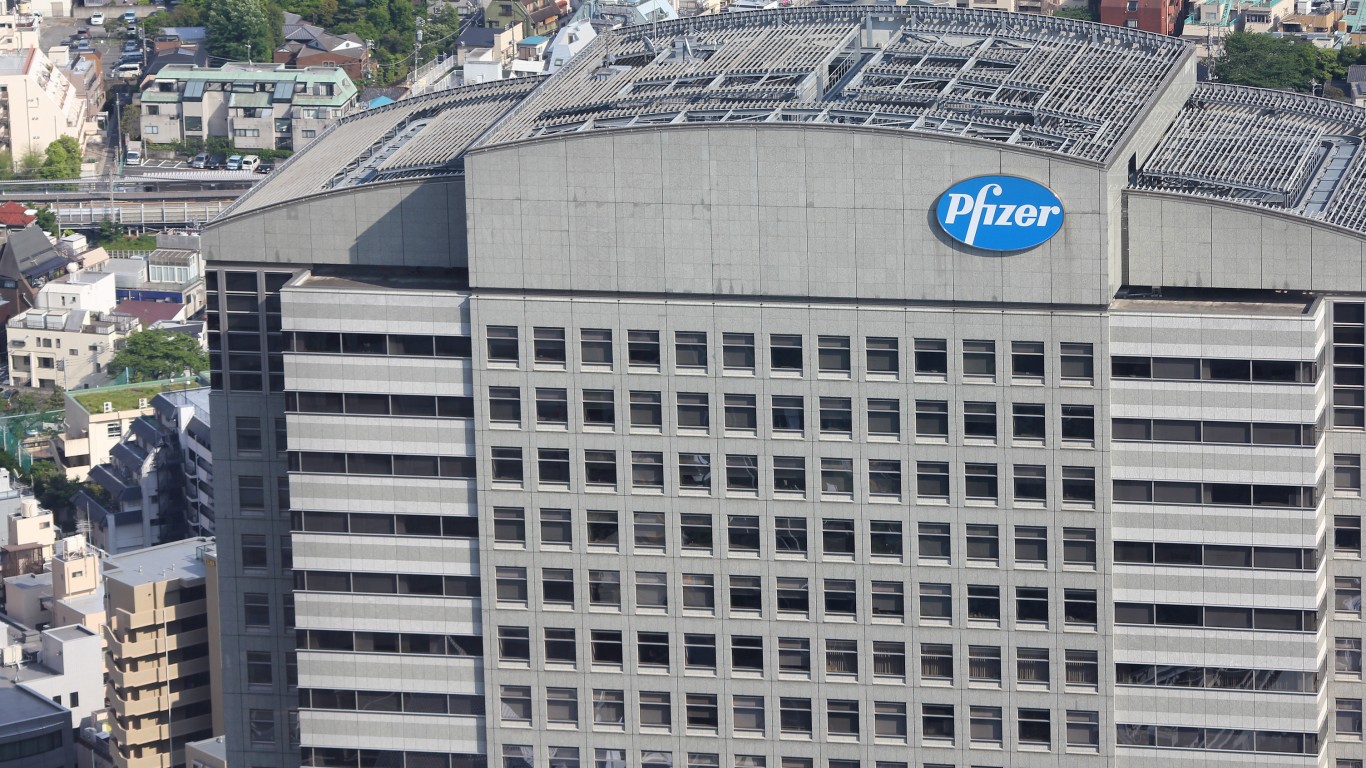
41. Pfizer
> Toxic hazard (pounds released x toxicity): 343,093,342
> Environmental justice, poor population share 31% – #50 highest out of 100 corporations
> Environmental justice, minority population share 20% – #62 highest
> Pct. of toxic hazard from a single facility: 100% – #1 highest
Of the three pharmaceutical plants owned by Pfizer or its subsidiaries that require water pollution permits, the facility in Portage, Minnesota, is responsible for near 100% of the company’s toxic wastewater, including over 1.4 million pounds that are discharged into a sewage treatment plant, and 240 pounds that are permitted to be released onto Minnesota’s surface waters.

40. NiSource
> Toxic hazard (pounds released x toxicity): 364,539,913
> Environmental justice, poor population share 25% – #70 highest out of 100 corporations
> Environmental justice, minority population share 17% – #71 highest
> Pct. of toxic hazard from a single facility: 100% – #1 highest
NiSource is the parent company of six gas and electric utilities, including Nipsco, which operates in Indiana. Of Nipsco’s two power facilities, its Michigan City facility is responsible for 99.97% of the company’s water pollution. Nipsco is now focusing on closing its dirty coal-fired plants ahead of schedule and transitioning to renewables – wind and solar – and battery technology. In the meantime, Nipsco is replacing the coal that produces energy to meet peak demands with much cleaner natural gas.
[in-text-ad]

39. Southern Company
> Toxic hazard (pounds released x toxicity): 371,666,196
> Environmental justice, poor population share 36% – #32 highest out of 100 corporations
> Environmental justice, minority population share 38% – #32 highest
> Pct. of toxic hazard from a single facility: 43% – #87 highest
Operating in Georgia and Alabama, two of Southern’s 10 electrical generating plants, the Barry plant in Alabama and the Wansley Steam Electric Generating Plant in Georgia, release most of the company’s most toxic wastewater – and it goes directly into surface waters. The main source of the contaminants is coal ash that has been stored in unlined landfills, which historically, were not required to be lined in some states.
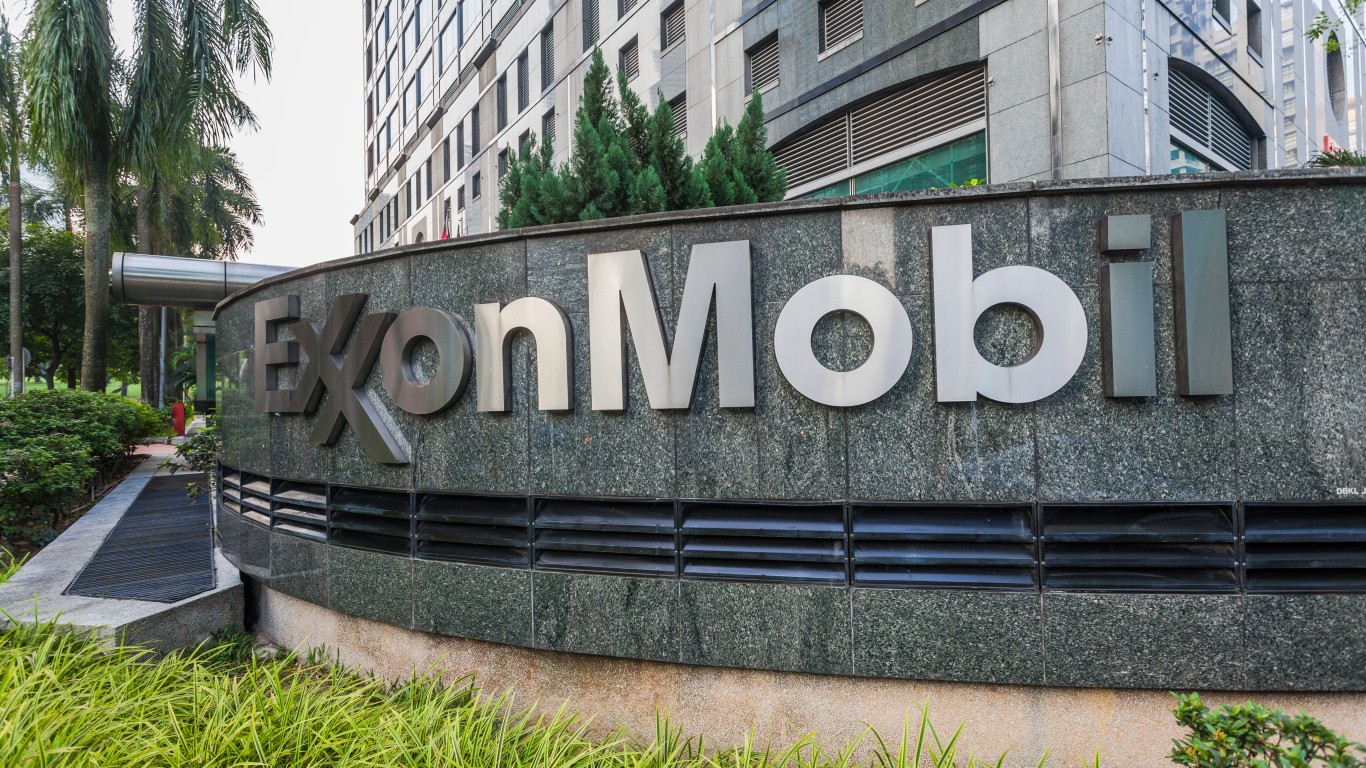
38. Exxon Mobil
> Toxic hazard (pounds released x toxicity): 385,872,409
> Environmental justice, poor population share 38% – #25 highest out of 100 corporations
> Environmental justice, minority population share 78% – #5 highest
> Pct. of toxic hazard from a single facility: 25% – #98 highest
Among Exxon Mobil’s chemical plants, refineries and terminals, four facilities discharge 90% of the company’s wastewater. Three of these are upstream of large minority populations: 82% of the population around Exxon’s Baton Rouge chemical plant is black, 55% of the population around its Beaumant, Texas, plant is minority, and 50% of the population downstream the Baton Rouge Refinery is minority, predominantly black. Over a third of the population in each of these locations lives in poverty.
37. Packaging Corporation of America
> Toxic hazard (pounds released x toxicity): 401,771,594
> Environmental justice, poor population share 46% – #5 highest out of 100 corporations
> Environmental justice, minority population share 18% – #67 highest
> Pct. of toxic hazard from a single facility: 54% – #81 highest
Packaging Corporation of America operates six containerboard mills and two white paper mills, each in a different state, and all but one of the mills is in locations with high poverty rates, ranging from 29.4% to 52.6% of the population surrounding the various plants. The company releases all of its million plus pounds of toxic wastewater directly into surface waters.
[in-text-ad-2]

36. PPL Corp.
> Toxic hazard (pounds released x toxicity): 419,448,015
> Environmental justice, poor population share 34% – #44 highest out of 100 corporations
> Environmental justice, minority population share 7% – #86 highest
> Pct. of toxic hazard from a single facility: 91% – #49 highest
PPL operates electric generating plants in Kentucky, one of which, the Ghent coal-fired plant, is responsible for over 90% of the company’s toxic wastewater releases. The water pollution emanates from unlined coal ash pits that have been storing coal ash at the facility since 1974, currently at the rate of 5.5 million tons of ash a year, spread over 800 acres.
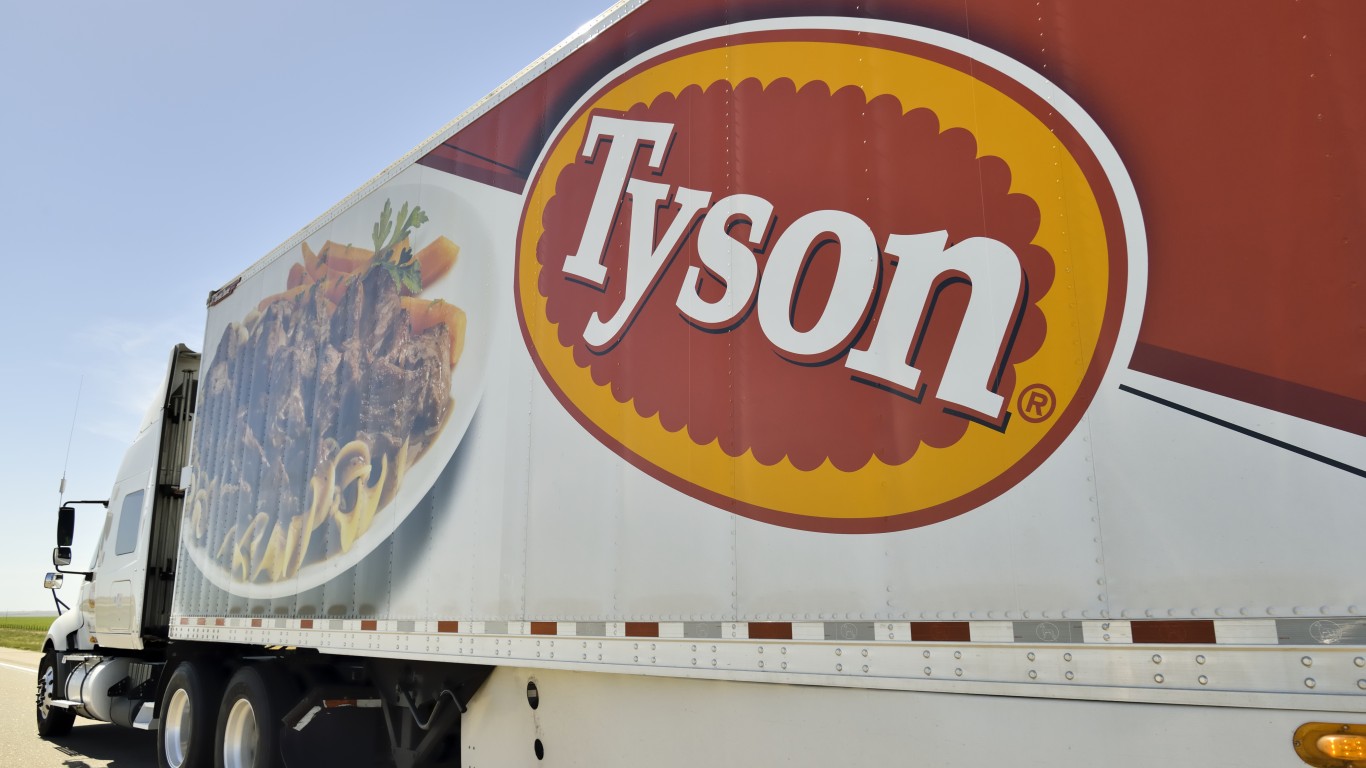
35. Tyson Foods
> Toxic hazard (pounds released x toxicity): 422,885,678
> Environmental justice, poor population share 17% – #89 highest out of 100 corporations
> Environmental justice, minority population share 20% – #62 highest
> Pct. of toxic hazard from a single facility: 96% – #40 highest
The world’s largest chicken processor and a $4 billion family business, Tyson foods kills 25 million chickens a week at its main plant in Springdale, Arkansas. The wastewater from its operations, containing both chemicals and animal waste, has contributed to high pollution levels in the 600 miles of streams in the northwestern part of the state, making the water in half of those miles undrinkable and unswimmable.
[in-text-ad]

34. PBF Energy
> Toxic hazard (pounds released x toxicity): 439,908,086
> Environmental justice, poor population share 31% – #50 highest out of 100 corporations
> Environmental justice, minority population share 41% – #30 highest
> Pct. of toxic hazard from a single facility: 89% – #50 highest
Three out of six of PBF’s refineries are in poor, heavily minority communities. However, the refinery with the company’s largest releases of toxic wastewater is its Torrance facility in California, which is an outlier for the petrochemical industry generally, as it is located in a relatively upscale region.
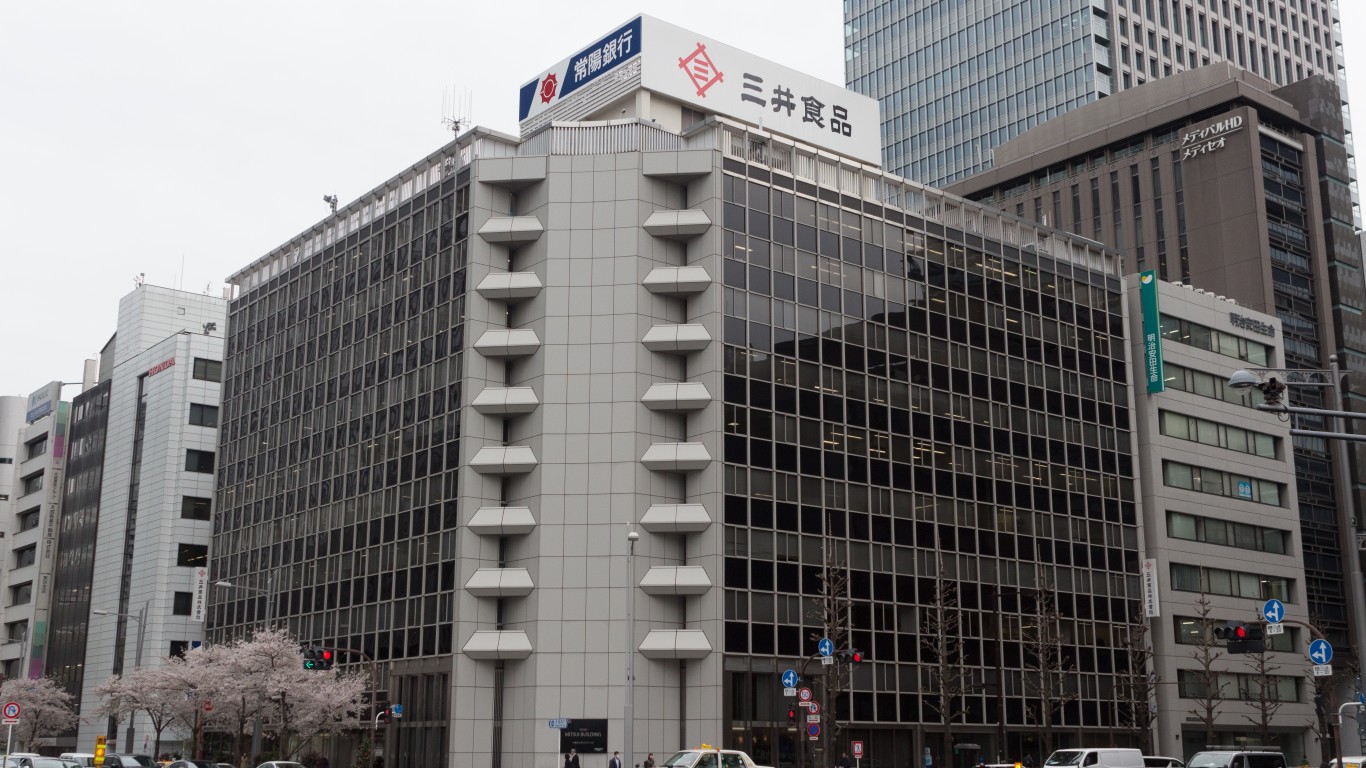
33. Mitsui
> Toxic hazard (pounds released x toxicity): 474,482,142
> Environmental justice, poor population share 40% – #20 highest out of 100 corporations
> Environmental justice, minority population share 55% – #16 highest
> Pct. of toxic hazard from a single facility: 100% – #1 highest
Virtually all of Mitsui’s toxic wastewater is released by the company’s subsidiary, Denka Performance Elastomer Ltd., formed when Mitsui purchased DuPont’s neoprene polychloroprene business in Louisiana in 2015. It is located in a largely poor, minority neighborhood. The most dangerous chemical in the wastewater is 1,4-Dichloro-2-butene, considered acutely toxic, corrosive, a likely human carcinogen, and highly toxic to aquatic life. The plant releases about 51 pounds of the chemical compound into local surface waters every year.
32. International Paper
> Toxic hazard (pounds released x toxicity): 558,086,650
> Environmental justice, poor population share 37% – #30 highest out of 100 corporations
> Environmental justice, minority population share 32% – #42 highest
> Pct. of toxic hazard from a single facility: 27% – #97 highest
Incorporated in 1898, International Paper is the largest pulp and paper company in the world, operating over two dozen mills in the United States. It takes pride in its sustainability. Sixty-nine percent of its business is commercial packaging, with processes that recycle 7 million tons of cardboard and paper every year.
[in-text-ad-2]
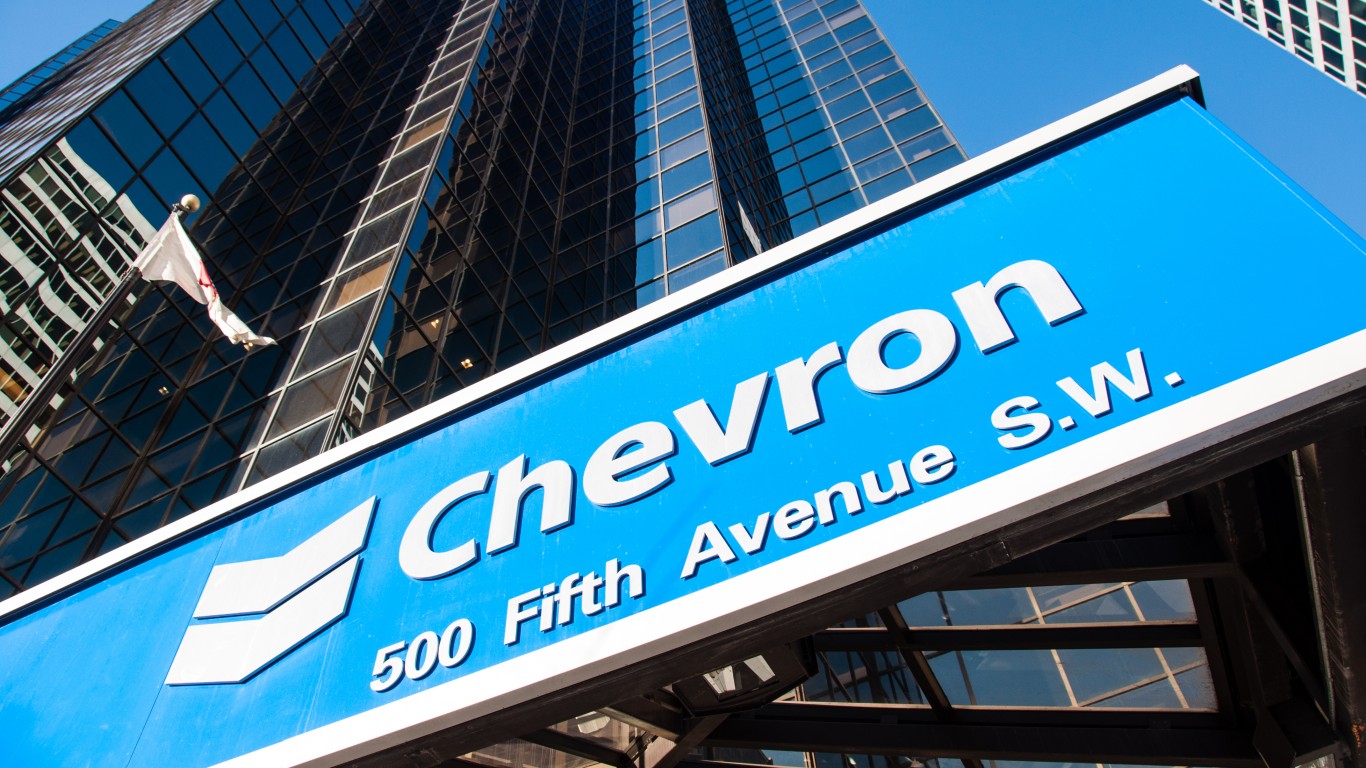
31. Chevron
> Toxic hazard (pounds released x toxicity): 561,582,366
> Environmental justice, poor population share 23% – #78 highest out of 100 corporations
> Environmental justice, minority population share 27% – #50 highest
> Pct. of toxic hazard from a single facility: 62% – #75 highest
Chevron operates 15 refineries, terminals, and chemical plants in the United States that require permits for water pollution, two of which, one in Texas and the other in Mississippi, release almost 62% of the company’s toxic wastewater. The Texas refinery was out of compliance with its water permits in five of a recent 12 quarters, and the Mississippi plant in two.
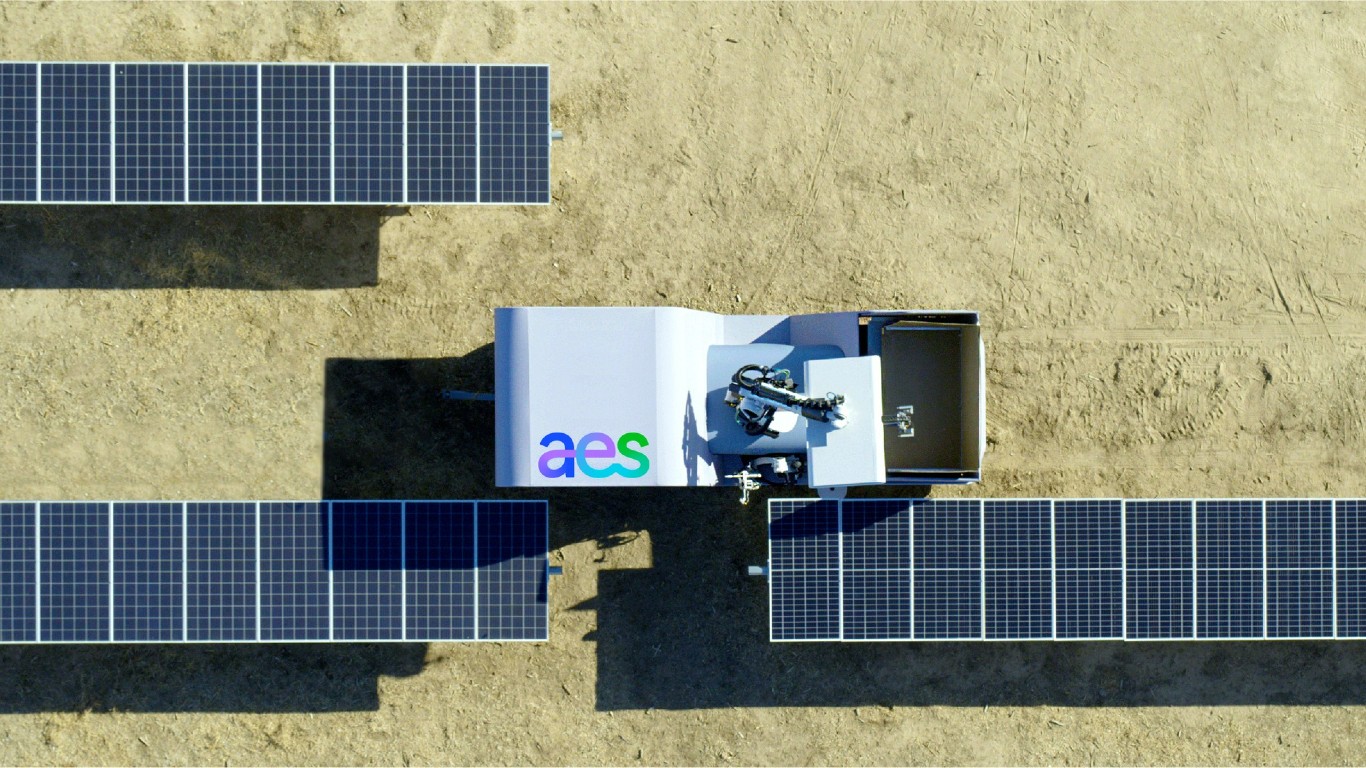
30. AES Corp.
> Toxic hazard (pounds released x toxicity): 582,628,303
> Environmental justice, poor population share 29% – #58 highest out of 100 corporations
> Environmental justice, minority population share 2% – #97 highest
> Pct. of toxic hazard from a single facility: 99% – #29 highest
AES Corp.’s IPL Petersburg power plant in Indiana is responsible for almost all of the company’s water pollution, and it has a very bad record for following its water permit requirements. It was out of compliance for 10 out of 12 recent quarters, and for eight of these it was cited for “significant violations.”
[in-text-ad]

29. NextEra Energy
> Toxic hazard (pounds released x toxicity): 627,708,193
> Environmental justice, poor population share 25% – #70 highest out of 100 corporations
> Environmental justice, minority population share 21% – #58 highest
> Pct. of toxic hazard from a single facility: 100% – #1 highest
Four power plants owned by NextEra Energy, all in Florida, have water pollution permits, but one of them, Gulf Clean Energy Center, is responsible for 100% of the company’s toxic wastewater discharges. It is generally in full compliance with its permit and does not have an enforcement history for water violations.
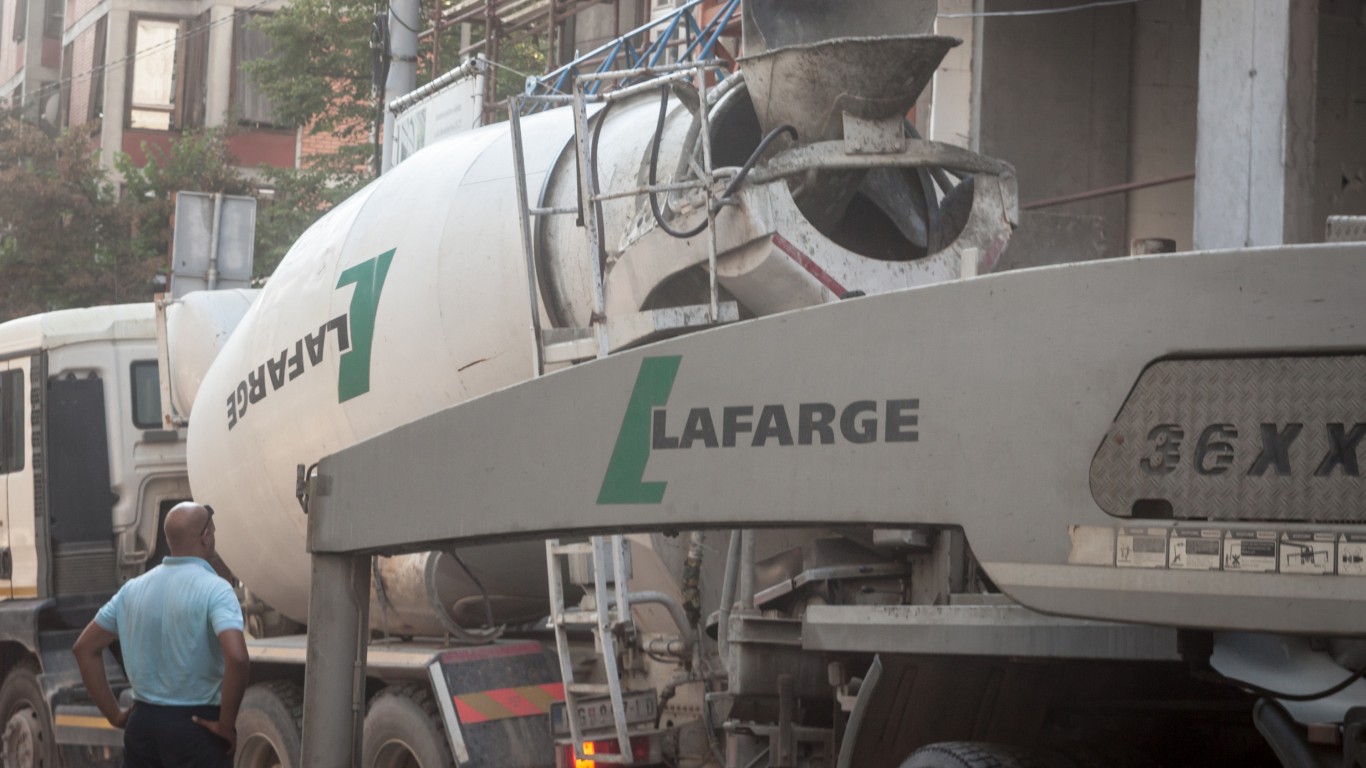
28. LafargeHolcim
> Toxic hazard (pounds released x toxicity): 664,561,763
> Environmental justice, poor population share 33% – #47 highest out of 100 corporations
> Environmental justice, minority population share 38% – #32 highest
> Pct. of toxic hazard from a single facility: 100% – #1 highest
Nearly 100% of LafargeHolcim’s toxic wastewater is released from its cement plant in Whitehall, Pennsylvania, and into waters in census tracts where a third of the population lives in poverty and 38% is minority, primarily Hispanic.

27. Renco
> Toxic hazard (pounds released x toxicity): 713,589,163
> Environmental justice, poor population share 38% – #25 highest out of 100 corporations
> Environmental justice, minority population share 5% – #92 highest
> Pct. of toxic hazard from a single facility: 94% – #42 highest
Renco’s most polluting plant, a metals recycling facility, is located upstream of a community in Missouri, where 37% of the population lives below twice the poverty line. Five out of six of the company’s other polluting plants – mills, mines, and smelters – discharge pollutants into waters adjacent to poor communities, with poverty rates ranging from 35.1% to 47.3%.
[in-text-ad-2]

26. Vistra Energy
> Toxic hazard (pounds released x toxicity): 861,167,163
> Environmental justice, poor population share 18% – #88 highest out of 100 corporations
> Environmental justice, minority population share 3% – #96 highest
> Pct. of toxic hazard from a single facility: 77% – #59 highest
Based in Texas, Vistra Energy is the largest power generation company in the country. Thirteen of the company’s power plants release toxic wastewater into their local POTW or surface waters, with over 96% discharged from two of the company’s plants in Ohio, mainly the Dynegy Miami Fort LLC plant in North Bend, where nearly a third of the population lives in poverty.

25. Marathon Petroleum
> Toxic hazard (pounds released x toxicity): 918,694,955
> Environmental justice, poor population share 25% – #70 highest out of 100 corporations
> Environmental justice, minority population share 21% – #58 highest
> Pct. of toxic hazard from a single facility: 41% – #89 highest
While Marathon’s many plants and refineries, taken together, are located in communities that are 21% minority, the two that contribute over 73% of the toxic water pollution, the Tesoro refineries in Los Angeles and Salt Lake City, are in communities with large minority populations, 74.3% and 59.1%, respectively, mostly Hispanic.
[in-text-ad]
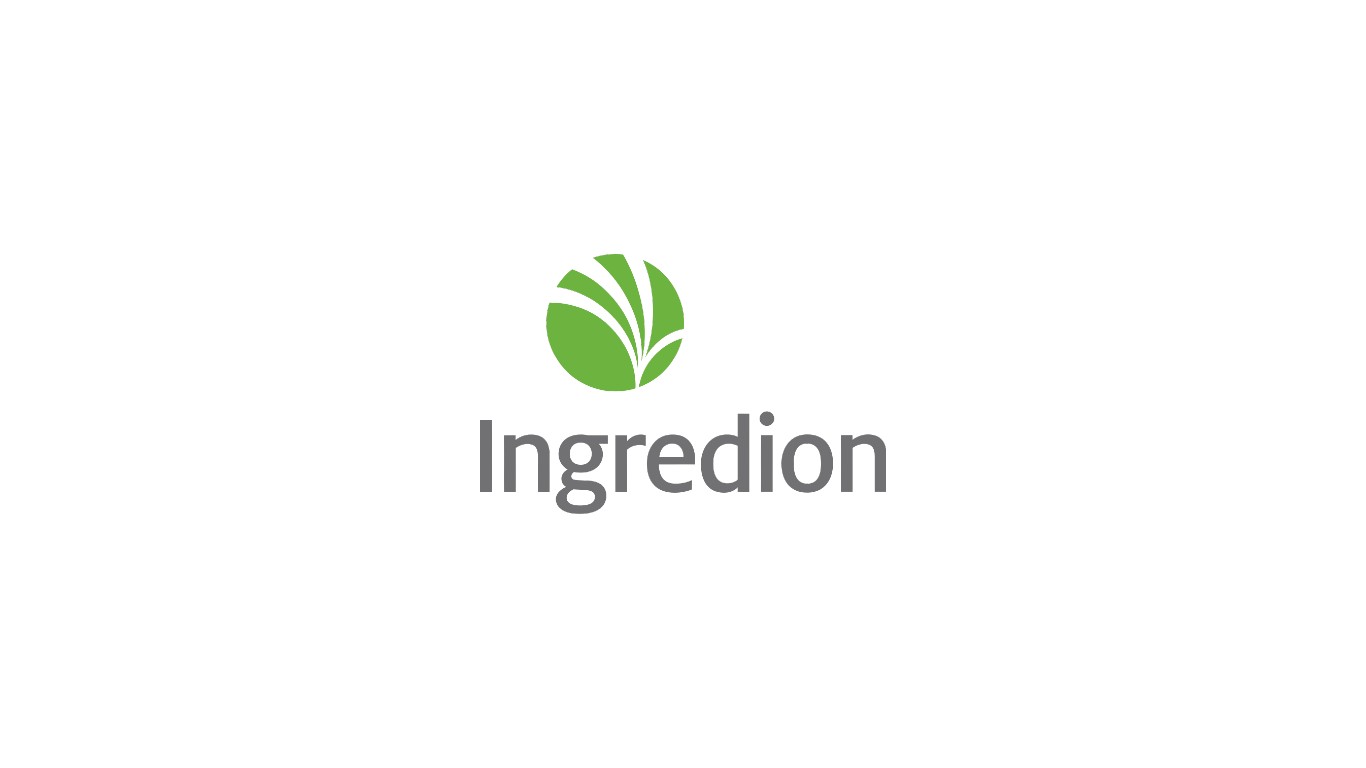
24. Ingredion
> Toxic hazard (pounds released x toxicity): 946,206,213
> Environmental justice, poor population share 26% – #66 highest out of 100 corporations
> Environmental justice, minority population share 16% – #73 highest
> Pct. of toxic hazard from a single facility: 100% – #1 highest
Ingredion is a manufacturer of sweeteners, starches, and other food ingredients. Until 2021, it also manufactured ethanol in its Cedar Rapids plant, the facility responsible for close to 100% of its toxic wastewater. With the elimination of its ethanol operation, the company would go from being the 24th largest discharger of toxics into water to releasing relatively miniscule, unremarkable amounts.
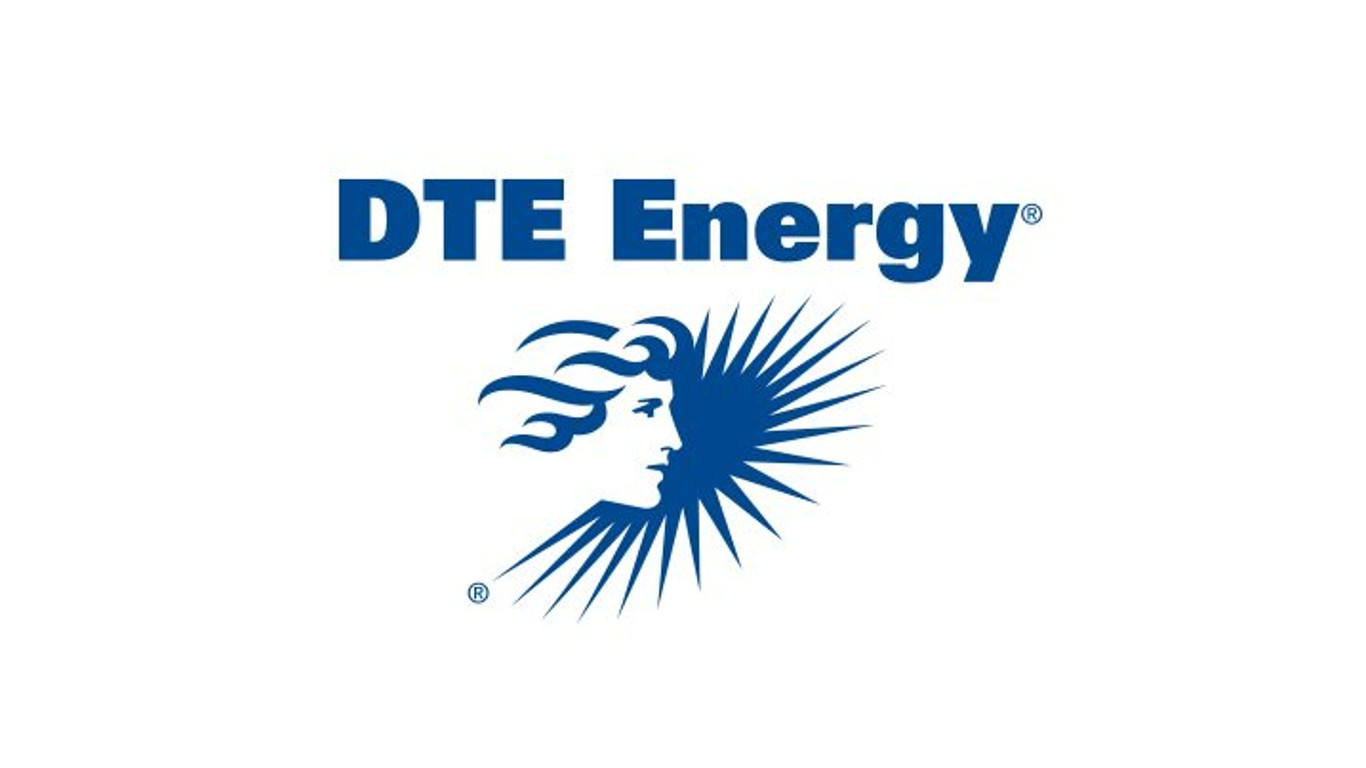
23. DTE Energy
> Toxic hazard (pounds released x toxicity): 991,448,016
> Environmental justice, poor population share 29% – #58 highest out of 100 corporations
> Environmental justice, minority population share 30% – #46 highest
> Pct. of toxic hazard from a single facility: 98% – #33 highest
DTE has struggled with criticism for the pollutants it emits into the air from its coal-fired Monroe Power Plant and has invested heavily in technology that removes toxins and other pollutants from its stacks. As a result, DTE’s water discharges are toxic. According to a Detroit Free Press report, citing 2015 EPA data, DTE released more arsenic in its wastewater than any other coal plant in the country, all of it going directly into Lake Erie.
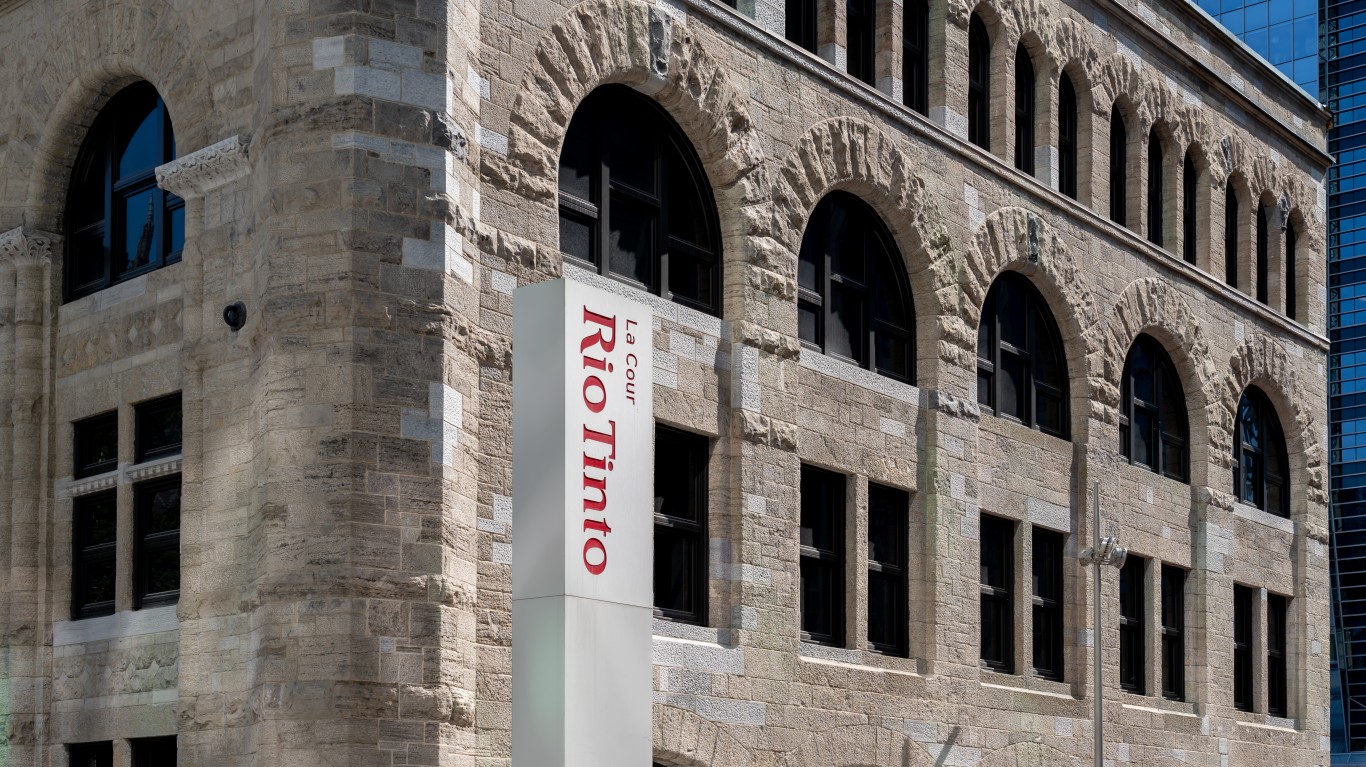
22. Rio Tinto
> Toxic hazard (pounds released x toxicity): 1,109,338,199
> Environmental justice, poor population share 8% – #98 highest out of 100 corporations
> Environmental justice, minority population share 19% – #66 highest
> Pct. of toxic hazard from a single facility: 71% – #64 highest
The immense amount of toxic material released into the environment by Rio Tinto comes from only two facilities, Kennecott Utah Copper Smelter and Refinery and Kennecott Utah Copper Mine Concentrators & Power Plant. The facilities release toxic wastewater from several outfalls into surface waters pursuant to a state permit, but in the days prior to environmental regulation, the company’s poor management of toxic waste resulted in Rio Tinto now being responsible for the remediation of a federal Superfund site.
[in-text-ad-2]
21. Cleveland-Cliffs
> Toxic hazard (pounds released x toxicity): 1,238,869,246
> Environmental justice, poor population share 35% – #39 highest out of 100 corporations
> Environmental justice, minority population share 25% – #53 highest
> Pct. of toxic hazard from a single facility: 85% – #54 highest
Operating primarily in West Virginia and the Midwest, Cleveland-Cliffs’ 24 facilities are mainly related to steel production and finishing, and include mines, mills, and manufacturing plants. More than 85% of its toxic wastewater is discharged from the company’s own treatment plant at its Mountain State Carbon coke plant. The plant, which has been in “significant violation” of its water discharge permit for at least the past three years, will be closing this year to reduce the company’s carbon air emissions.
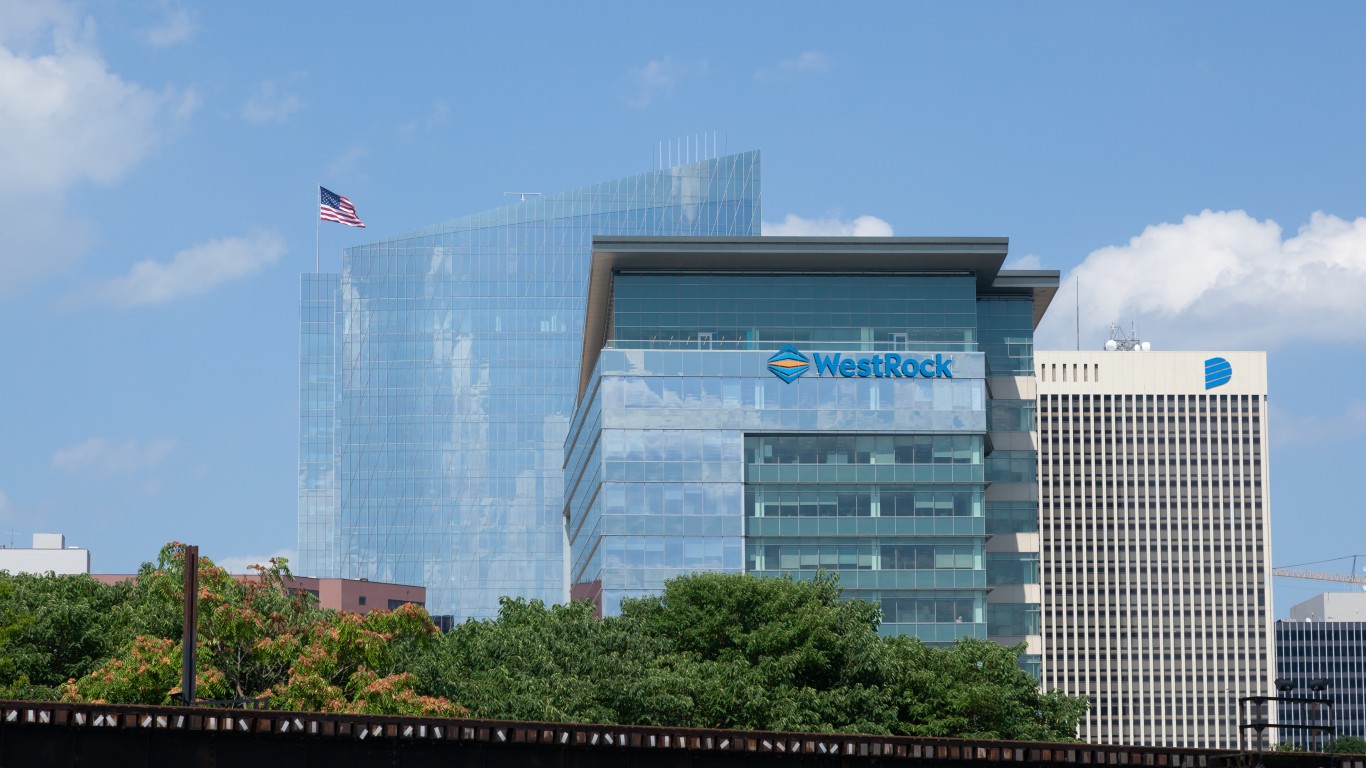
20. WestRock
> Toxic hazard (pounds released x toxicity): 1,418,051,727
> Environmental justice, poor population share 28% – #61 highest out of 100 corporations
> Environmental justice, minority population share 36% – #36 highest
> Pct. of toxic hazard from a single facility: 76% – #60 highest
With facilities in 30 countries and over two dozen facilities in the U.S., WestRock gets a poor ranking for water pollution because of its size and the nature of its business. It is one of the largest paper and packaging companies in the world. Paper making requires immense amounts of water, much of which can be treated and recycled, but ultimately most of the water used in manufacturing processes becomes contaminated with toxic materials and is released into the environment pursuant to state or federal permits.
[in-text-ad]
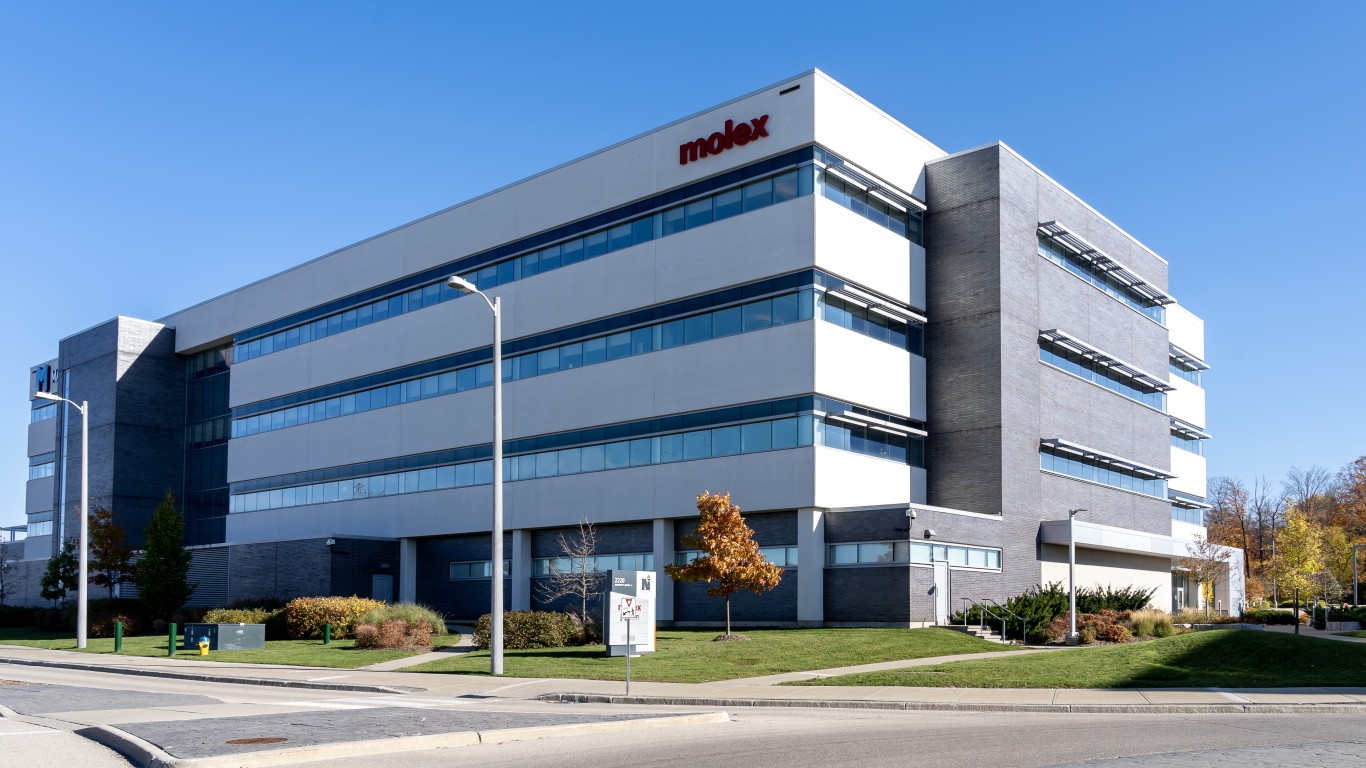
19. Koch Industries
> Toxic hazard (pounds released x toxicity): 1,424,784,128
> Environmental justice, poor population share 36% – #32 highest out of 100 corporations
> Environmental justice, minority population share 18% – #67 highest
> Pct. of toxic hazard from a single facility: 13% – #100 highest
The most polluting of the scores of facilities run by Koch Industries are overwhelmingly located in poor regions. Twenty-two of its 30 most polluting plants are upstream of communities with higher than average poverty levels. The facility discharging the greatest amount of toxics into local waters is Alabama River Cellulose, located in an area where 64.6% of the population lives in poverty.

18. American Electric Power
> Toxic hazard (pounds released x toxicity): 1,450,819,085
> Environmental justice, poor population share 41% – #18 highest out of 100 corporations
> Environmental justice, minority population share 7% – #86 highest
> Pct. of toxic hazard from a single facility: 69% – #66 highest
American Electric Power operates a number of electric power plants, mainly in the South and Midwest, but only two, together, discharge over 94% of the company’s toxic wastewater. Among other chemicals, the two plants dumped over 900 pounds of arsenic compounds into local waters in 2019.

17. Berkshire Hathaway
> Toxic hazard (pounds released x toxicity): 1,832,737,906
> Environmental justice, poor population share 27% – #63 highest out of 100 corporations
> Environmental justice, minority population share 38% – #32 highest
> Pct. of toxic hazard from a single facility: 92% – #47 highest
Included in Berkshire Hathaway’s portfolio are interests in utilities, insurance companies, real estate, media, retail stores, foundries, and manufacturers of clothing, building materials, home furnishings, and recreational vehicles. Given the size and diversity of holdings it would be surprising if the international conglomerate under the leadership of Warren Buffett was not on a list of major polluters. And yet, only one of its companies, Lubrizol, a chemical manufacturer, is responsible for nearly 92% of the toxic wastewater Berkshire is credited with discharging into U.S. waters.
[in-text-ad-2]

16. Chemours
> Toxic hazard (pounds released x toxicity): 1,836,708,431
> Environmental justice, poor population share 34% – #44 highest out of 100 corporations
> Environmental justice, minority population share 26% – #51 highest
> Pct. of toxic hazard from a single facility: 89% – #50 highest
Six of Chemours chemical plants have spotty or worse water permit compliance records. It has also been the subject of several lawsuits over polluted groundwater and drinking water wells. The company, along with DuPont, which originally owned Chemours, agreed to pay over $400 million to settle charges of dumping the carcinogen perfluorooctanoate (PFOA) from a plant in West Virginia.
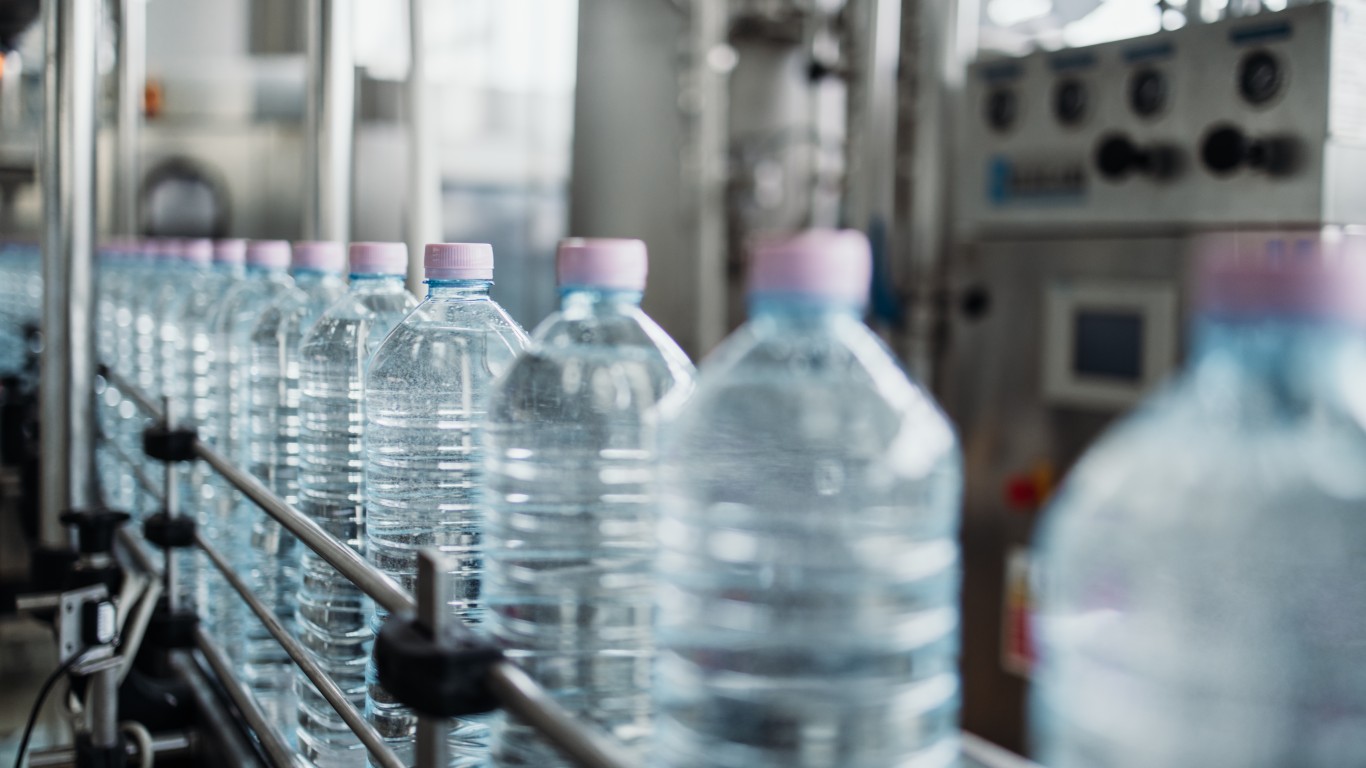
15. Far Easten New Century Corp.
> Toxic hazard (pounds released x toxicity): 1,966,969,554
> Environmental justice, poor population share 43% – #11 highest out of 100 corporations
> Environmental justice, minority population share 1% – #98 highest
> Pct. of toxic hazard from a single facility: 100% – #1 highest
Operating as APG Polytech in Apple Grove, West Virginia, the company produces polyethylene terephthalate, known as PET, used for, among other things, plastic soda bottles. It releases over 19,000 pounds of dioxane, an animal carcinogen and likely human carcinogen, into the Ohio River, pursuant to its wastewater discharge permit.
[in-text-ad]

14. Alfa S.A.B.
> Toxic hazard (pounds released x toxicity): 2,166,104,301
> Environmental justice, poor population share 25% – #70 highest out of 100 corporations
> Environmental justice, minority population share 29% – #49 highest
> Pct. of toxic hazard from a single facility: 82% – #57 highest
Alfa, a Mexican conglomerate, is one of the largest producers of PET in North America. Four of its plants – two in South Carolina, one in North Carolina, and one in Mississippi – together discharge over 21,000 pounds of dioxane into their states’ waters.

13. Energy Capital Partners
> Toxic hazard (pounds released x toxicity): 2,531,273,104
> Environmental justice, poor population share 43% – #11 highest out of 100 corporations
> Environmental justice, minority population share 30% – #46 highest
> Pct. of toxic hazard from a single facility: 93% – #45 highest
Energy Capital Partners earns its high toxic hazard score mainly due to its annual discharge of 1,500 lbs of arsenic from a single plant, Envirofocus Technologies, into Tampa, Florida’s POTW, which in turn discharges it all into public waters. However, Envirofocus is also playing an important role in environmental waste management as a reprocessor of scrap metal.
12. Boston Scientific
> Toxic hazard (pounds released x toxicity): 2,580,001,087
> Environmental justice, poor population share 24% – #77 highest out of 100 corporations
> Environmental justice, minority population share 10% – #81 highest
> Pct. of toxic hazard from a single facility: 100% – #1 highest
In its manufacture of medical devices, Boston Scientific’s manufacturing plant in Maple Grove, Michigan, transfers over 2,500 pounds of thiourea to the local sewage treatment plant. Thiourea is a highly toxic material that has a sky-high toxic hazard score because it is both a carcinogen and a mutagen.
[in-text-ad-2]
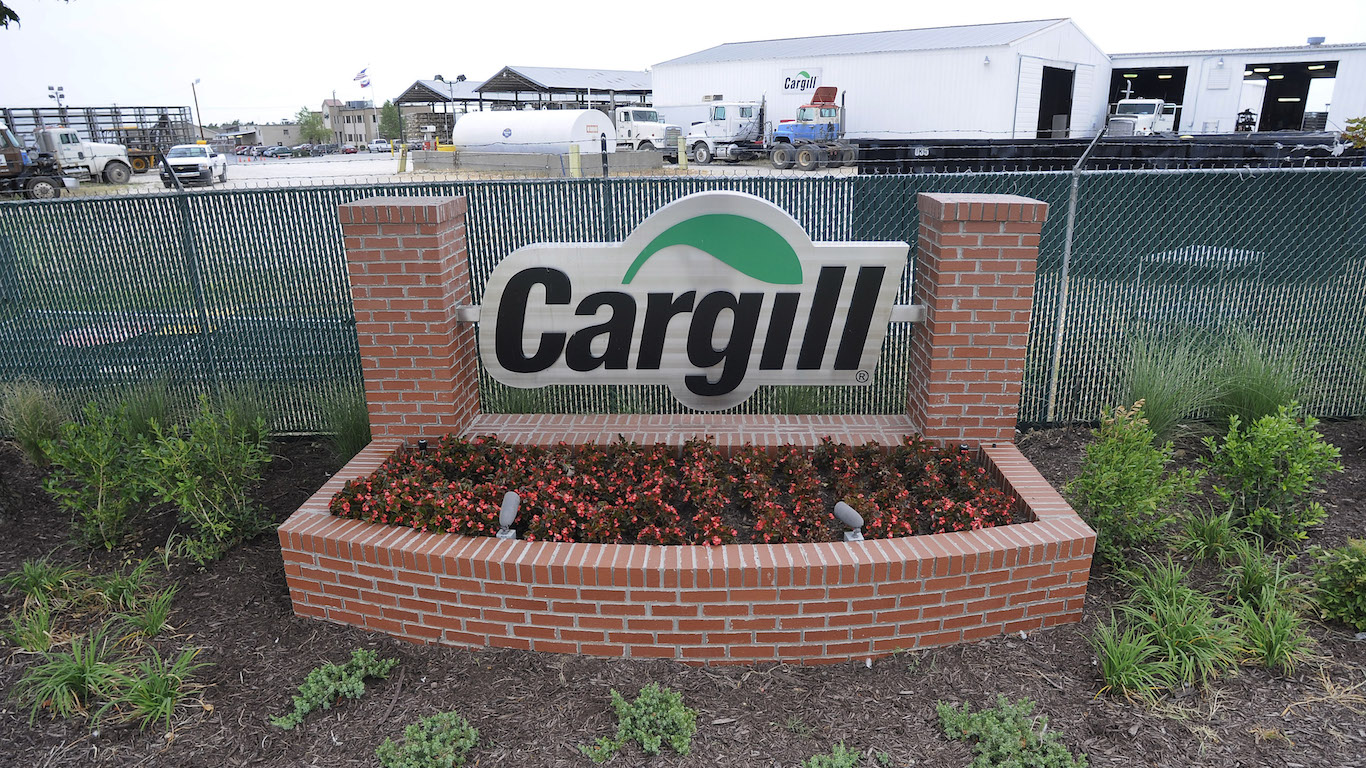
11. Cargill
> Toxic hazard (pounds released x toxicity): 2,687,920,789
> Environmental justice, poor population share 26% – #66 highest out of 100 corporations
> Environmental justice, minority population share 21% – #58 highest
> Pct. of toxic hazard from a single facility: 92% – #47 highest
Of the many Cargill facilities throughout the U.S., its corn milling plant in Cedar Rapids, Iowa, discharges the vast majority of the company’s toxic wastewater. All together, the mill releases to a POTW over 20,000 lbs of toxic material, including metals, acids, and other chemicals, the most dangerous of which are carcinogenic lead compounds.
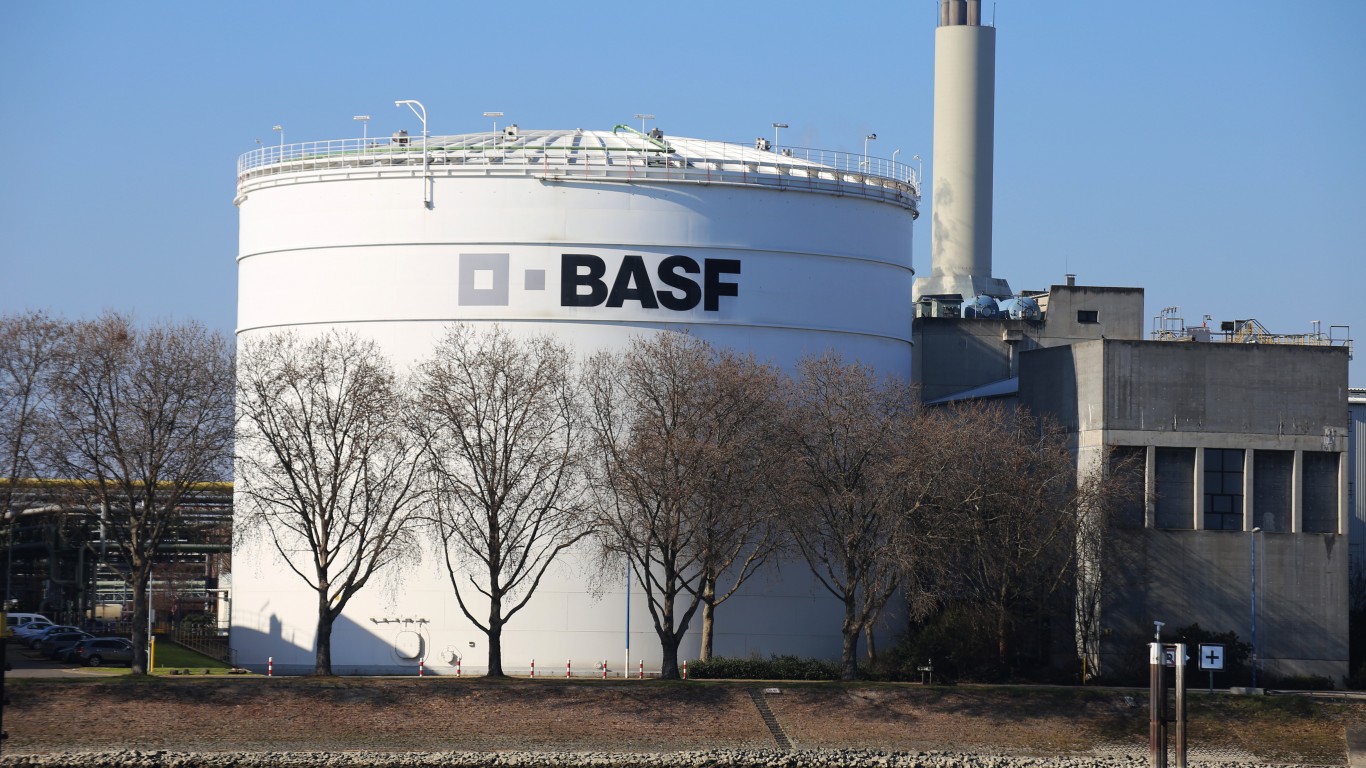
10. BASF
> Toxic hazard (pounds released x toxicity): 2,859,840,185
> Environmental justice, poor population share 25% – #70 highest out of 100 corporations
> Environmental justice, minority population share 12% – #79 highest
> Pct. of toxic hazard from a single facility: 53% – #84 highest
BASF is a German multinational corporation that owns scores of plants throughout the U.S., mainly in the South. More than half of its water pollution from its American facilities comes from its Wyandotte, Michigan, chemical plant.
[in-text-ad]
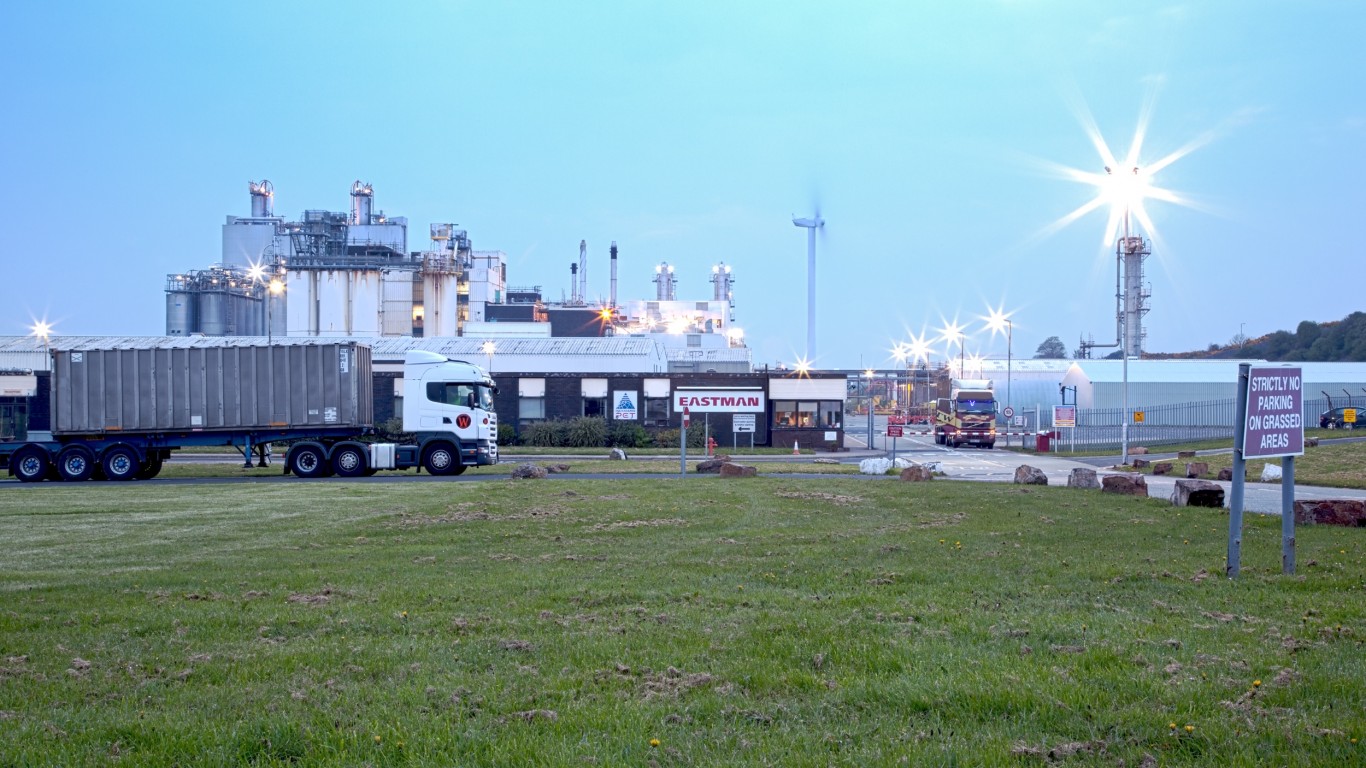
9. Eastman Chemical
> Toxic hazard (pounds released x toxicity): 3,931,110,749
> Environmental justice, poor population share 43% – #11 highest out of 100 corporations
> Environmental justice, minority population share 17% – #71 highest
> Pct. of toxic hazard from a single facility: 94% – #42 highest
Eastman Chemical is a global manufacturing company specializing in advanced materials, chemicals, and fibers. Its Kingsport, Tennessee, plant was founded in 1920 by George Eastman, the photography popularizer and entrepreneur. The Kingsport facility is also currently responsible for almost all of the company’s water pollution, with a quarter of a million pounds of toxic wastewater going into Tennessee surface water.

8. Goodyear Tire & Rubber
> Toxic hazard (pounds released x toxicity): 3,936,322,205
> Environmental justice, poor population share 36% – #32 highest out of 100 corporations
> Environmental justice, minority population share 46% – #26 highest
> Pct. of toxic hazard from a single facility: 100% – #1 highest
Goodyear’s biggest and most polluting plant is in Niagara Falls, New York, where it releases a toxic brew into the local treatment plant. The most toxic chemical in the mix is hydroquinone, used in the manufacture of rubber. Contact with the chemical can have numerous effects – from eye cloudiness and rashes to headaches and nausea. Long-term exposure can cause organ damage. Drinking it is lethal.

7. Honeywell International
> Toxic hazard (pounds released x toxicity): 6,369,256,668
> Environmental justice, poor population share 39% – #23 highest out of 100 corporations
> Environmental justice, minority population share 47% – #23 highest
> Pct. of toxic hazard from a single facility: 100% – #1 highest
Plagued by chemical leaks and employee deaths related to chemical exposure, the Geismar Honeywell plant in Carville, Louisiana, produces almost all of the company’s toxic wastewater. It is located upstream of a community that is more than half minority, and over 39% of nearby residents live in poverty.
[in-text-ad-2]

6. Duke Energy
> Toxic hazard (pounds released x toxicity): 6,765,810,638
> Environmental justice, poor population share 19% – #87 highest out of 100 corporations
> Environmental justice, minority population share 8% – #85 highest
> Pct. of toxic hazard from a single facility: 87% – #52 highest
Duke Energy’s generating plant in Cayuga, North Carolina, discharges 3,400 lbs of pollutants, mainly metals and arsenic into the state’s waters. The plant releases most of the company’s toxic wastewater. Duke energy has run into environmental problems from the unpermitted and unquantified pollutants emanating from its landfilled coal ash. In 2015, the company was required to pay $25.1 million in cleanup costs for groundwater polluted by coal ash at its Semora, North Carolina plant.

5. Canopus International
> Toxic hazard (pounds released x toxicity): 12,380,029,294
> Environmental justice, poor population share 45% – #7 highest out of 100 corporations
> Environmental justice, minority population share 35% – #38 highest
> Pct. of toxic hazard from a single facility: 64% – #73 highest
Canopus, a manufacturer of PET products, is a global corporation with subsidiaries known by the names StarPet, Indorama, and others in the U.S. The company’s StarPet plants’ discharges, which flow into waters in low-income areas, are reliably in regular compliance with the terms of its permit to discharge. This means that regulators have calculated that the relative amount of toxics in receiving waters is not a health threat.
[in-text-ad]
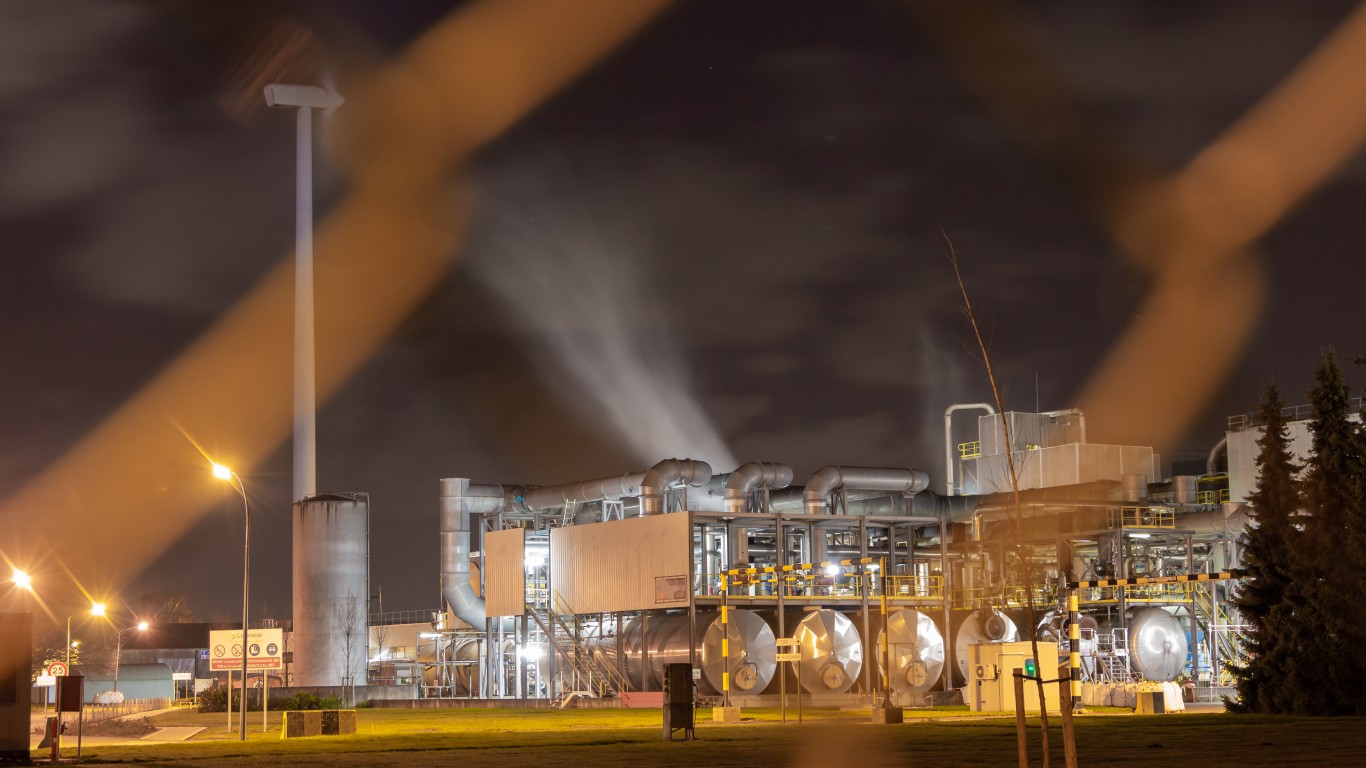
4. Celanese
> Toxic hazard (pounds released x toxicity): 28,892,205,441
> Environmental justice, poor population share 16% – #91 highest out of 100 corporations
> Environmental justice, minority population share 30% – #46 highest
> Pct. of toxic hazard from a single facility: 100% – #1 highest
The Celanese petrochemical facility in Pasadena, Texas, known as the Clear Lake Plant, discharges waste from the manufacture of acetic acid, vinyl acetate, and methanol. Following a recent expansion, Celanese began using captured carbon to make methanol, and the company expects to displace 180,000 metric tons of CO2 as part of its climate change strategy.
3. LyondellBasell
> Toxic hazard (pounds released x toxicity): 39,260,468,246
> Environmental justice, poor population share 16% – #91 highest out of 100 corporations
> Environmental justice, minority population share 31% – #44 highest
> Pct. of toxic hazard from a single facility: 95% – #41 highest
The Pasadena, Texas, facility of the multinational petrochemical giant LyondellBasell, manufactures chemicals, resins, and materials used in a range of consumer products, notably, polypropylene. It also produces nearly 1,800,000 lbs of chemical-laden wastewater that is transported to the local treatment plant, and, in turn, virtually untreated into surface waters.

2. Dow Inc.
> Toxic hazard (pounds released x toxicity): 41,732,499,631
> Environmental justice, poor population share 35% – #39 highest out of 100 corporations
> Environmental justice, minority population share 48% – #22 highest
> Pct. of toxic hazard from a single facility: 98% – #33 highest
Dow Chemical’s Freeport, Texas, plant, the company’s largest discharger of toxic wastewater, is upstream of a community that is 65.6% minority – mainly Hispanic – with about half of the population living in poverty. Dow touts its engagement with the community and its sponsorship of educational projects.
[in-text-ad-2]

1. Northrop Grumman
> Toxic hazard (pounds released x toxicity): 150,093,525,218
> Environmental justice, poor population share 34% – #44 highest out of 100 corporations
> Environmental justice, minority population share 10% – #81 highest
> Pct. of toxic hazard from a single facility: 100% – #1 highest
Northrop Grumman designs and builds aerospace and defense systems. Six of its plants discharge some small amounts of toxic water. The company’s plant in Radford, Virginia, Alliant Techsystems Operations LLC, also known as New River Energetics, releases large amounts – over 200,000 lbs annually – of highly toxic chemicals into the local POTW, and, therefore, the waters of the state of Virginia. In 2021, the company paid $350,000 in penalties for violations of its air permit, water permit, and waste storage regulations.
In 20 Years, I Haven’t Seen A Cash Back Card This Good
After two decades of reviewing financial products I haven’t seen anything like this. Credit card companies are at war, handing out free rewards and benefits to win the best customers.
A good cash back card can be worth thousands of dollars a year in free money, not to mention other perks like travel, insurance, and access to fancy lounges.
Our top pick today pays up to 5% cash back, a $200 bonus on top, and $0 annual fee. Click here to apply before they stop offering rewards this generous.
Flywheel Publishing has partnered with CardRatings for our coverage of credit card products. Flywheel Publishing and CardRatings may receive a commission from card issuers.
Thank you for reading! Have some feedback for us?
Contact the 24/7 Wall St. editorial team.

 24/7 Wall St.
24/7 Wall St. 24/7 Wall St.
24/7 Wall St.
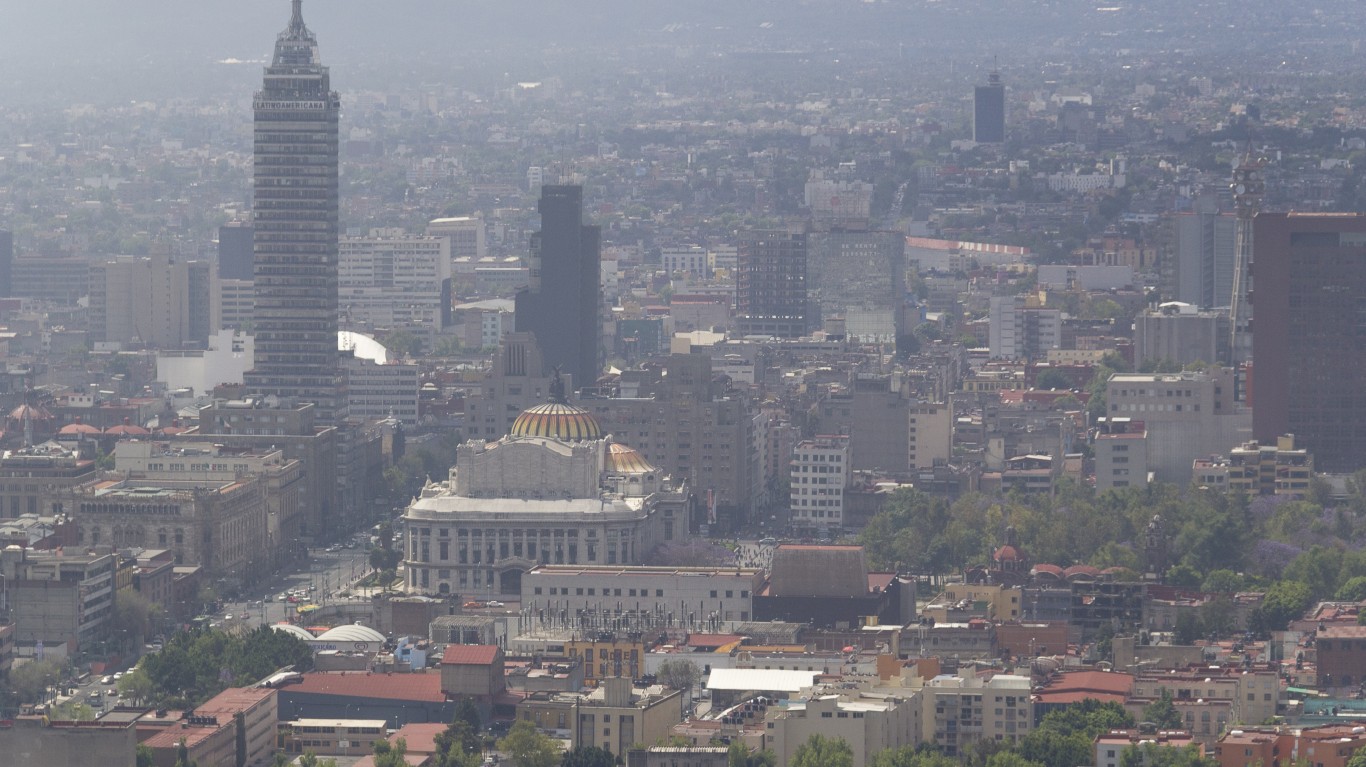 24/7 Wall St.
24/7 Wall St.
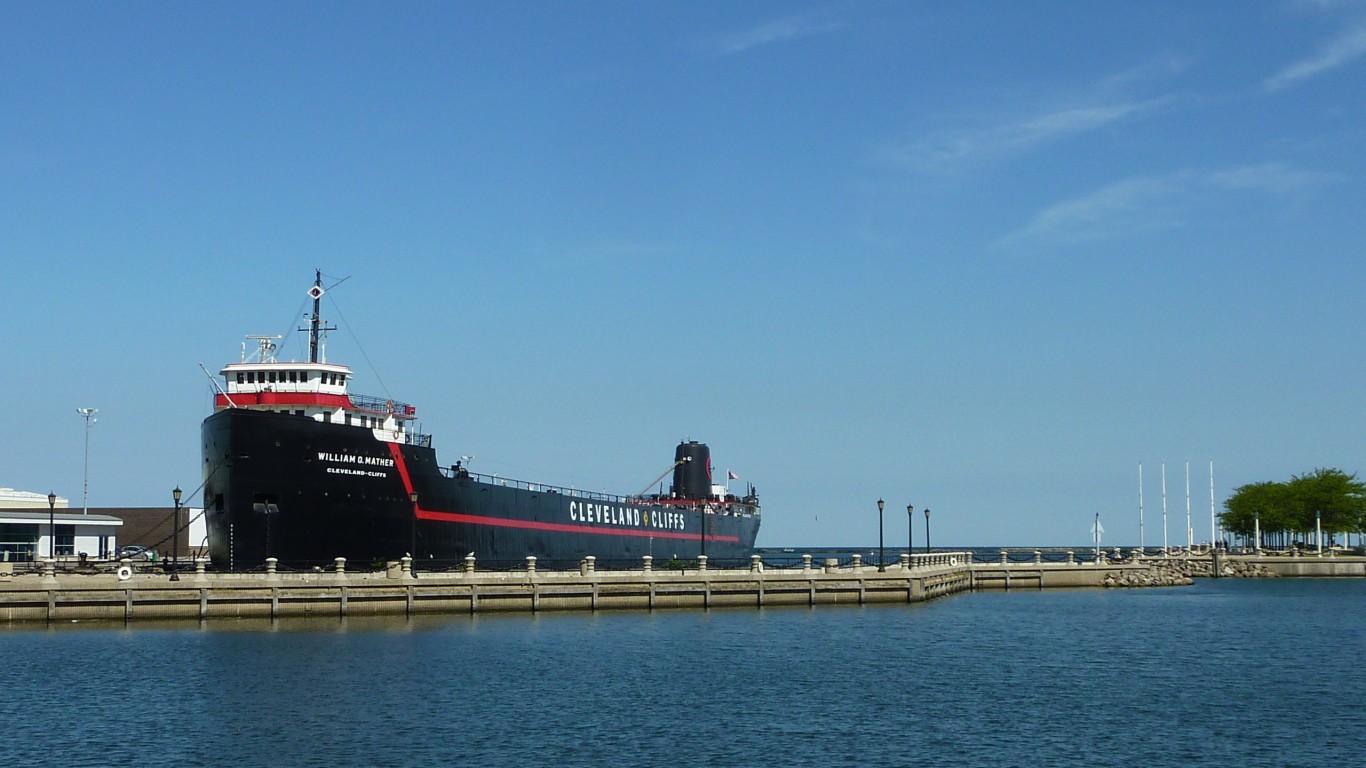
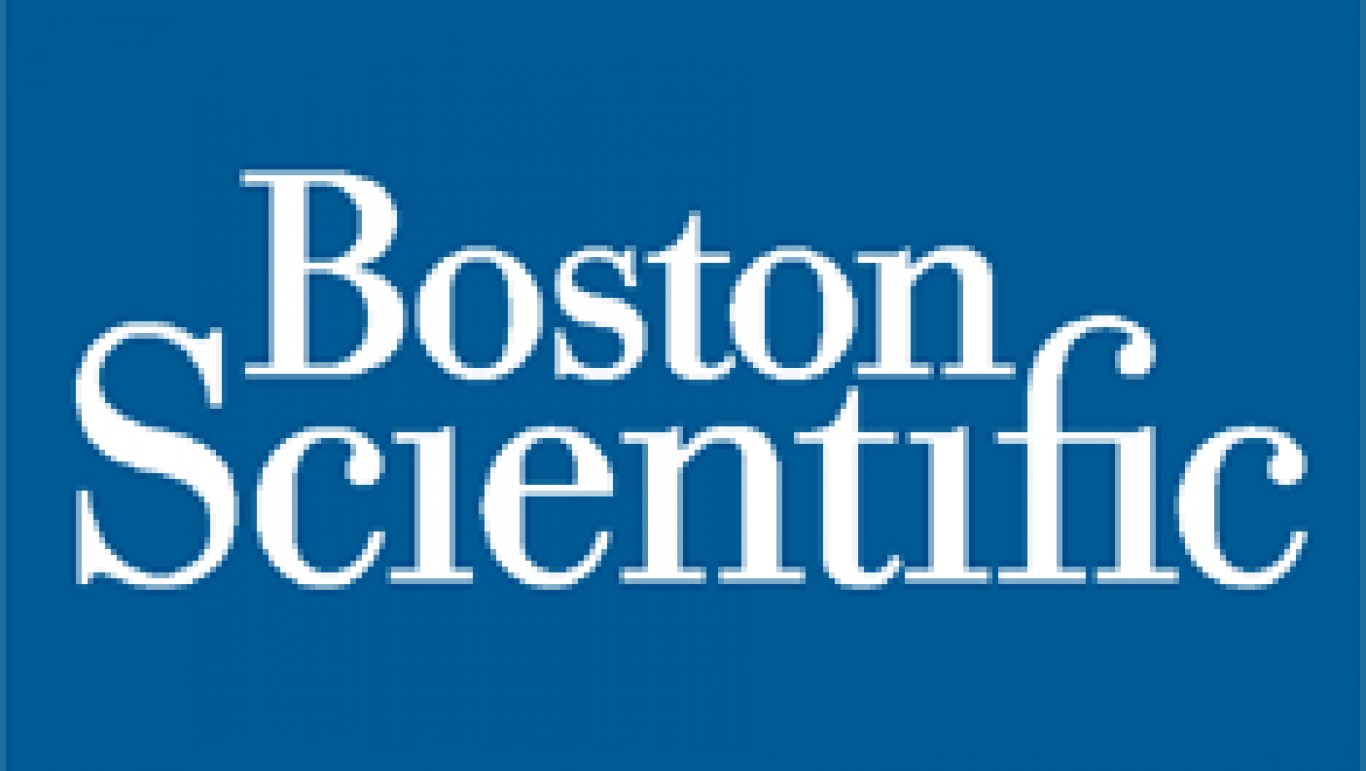
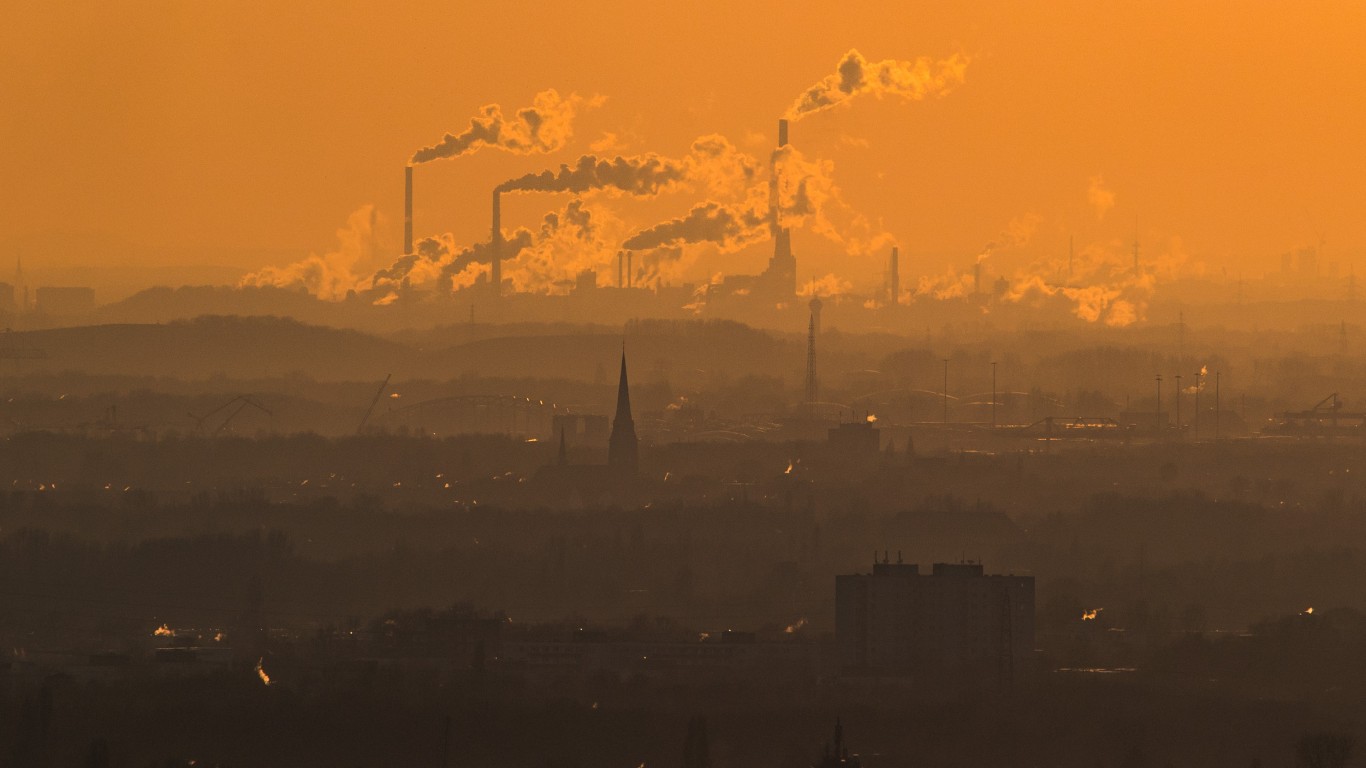 24/7 Wall St.
24/7 Wall St.